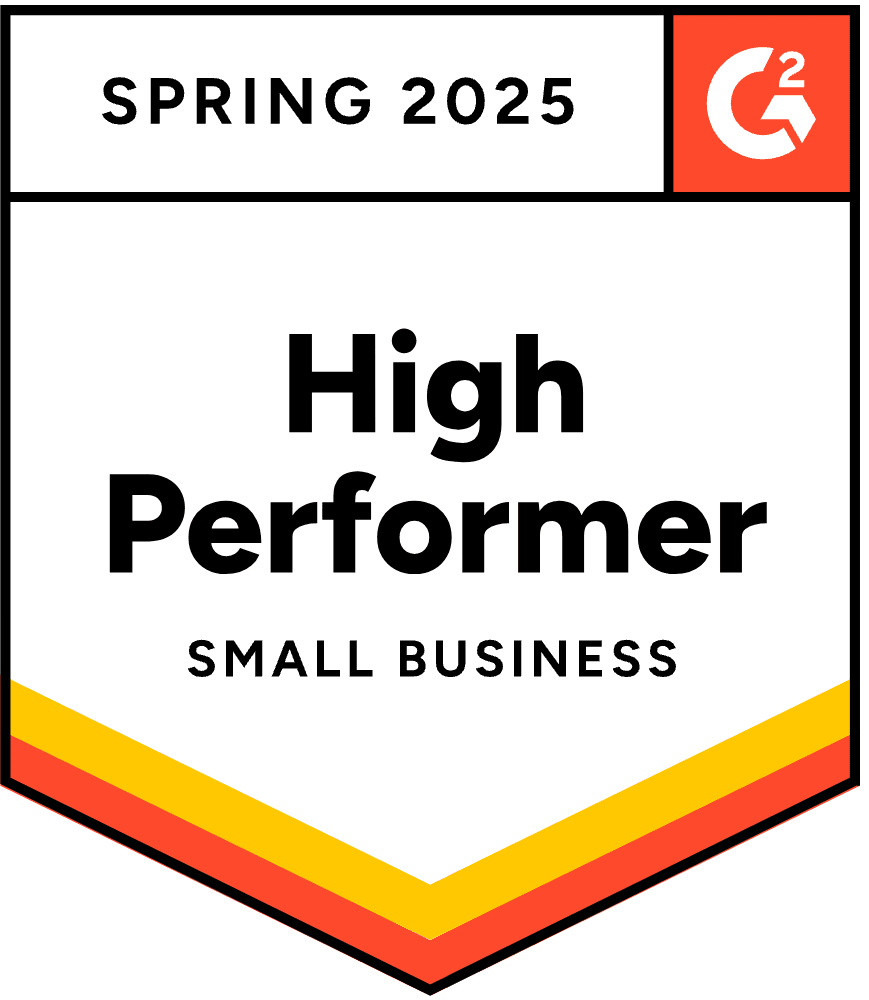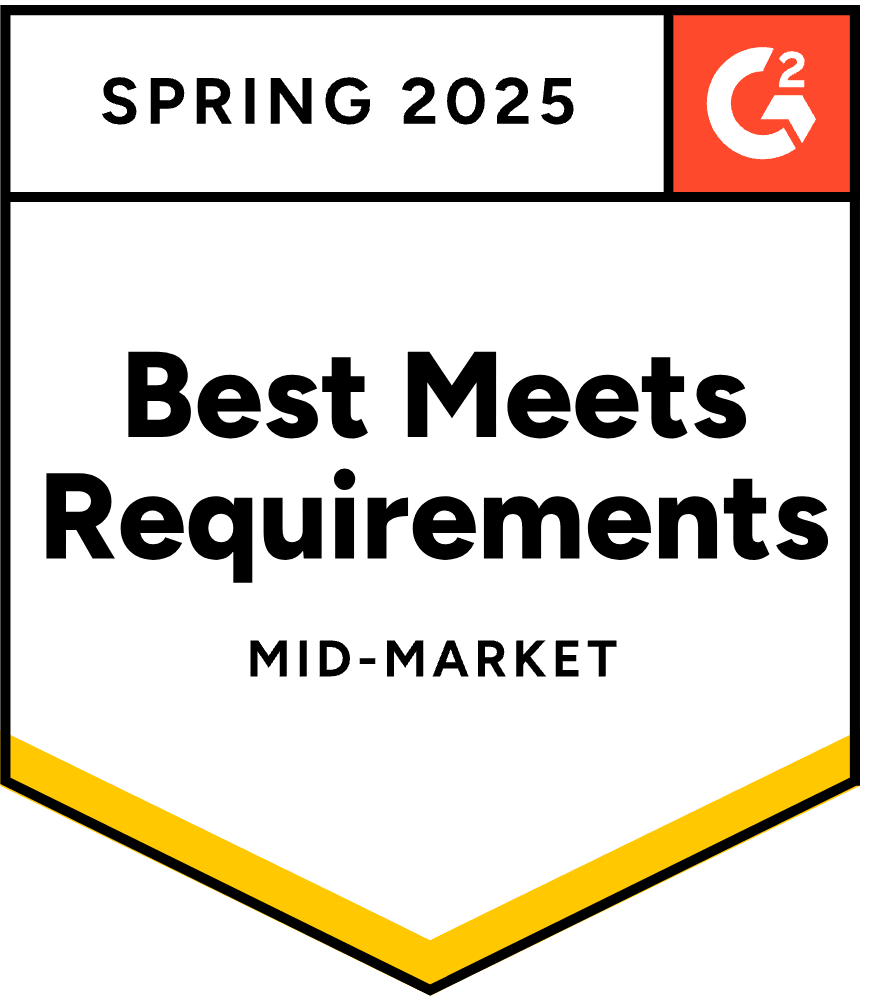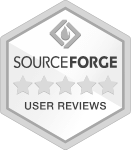- Blog
- 15 of the Best Product Page Examples We’ve Seen in 2025
15 of the Best Product Page Examples We’ve Seen in 2025
-
Barbara Bartucz
- Ecommerce
- 6 min read
Table of Contents
At the end of the day, the online shopping experience is all about products. If people aren’t interested in what you offer, you can use the most cutting-edge online marketing tactics, but you’ll still struggle to make an impact.
Your product pages are the best place to convince customers that what you’re selling is the perfect solution to the problem they’re trying to solve. After all, a product page is where users make their final purchase decision.
The best way to understand how to create effective ecommerce product pages is to examine how top online brands do it. In this article, we’ll take a look at the 15 best product page examples we’ve seen recently!
Let’s get right into it!
15 product page examples we love
Compelling product pages enable customers to understand all the elements of a product at a glance, feature high-quality product photography, and build an atmosphere of trust.
Here’s how 15 ecommerce sites accomplish these goals on their product pages.
1. BlendJet
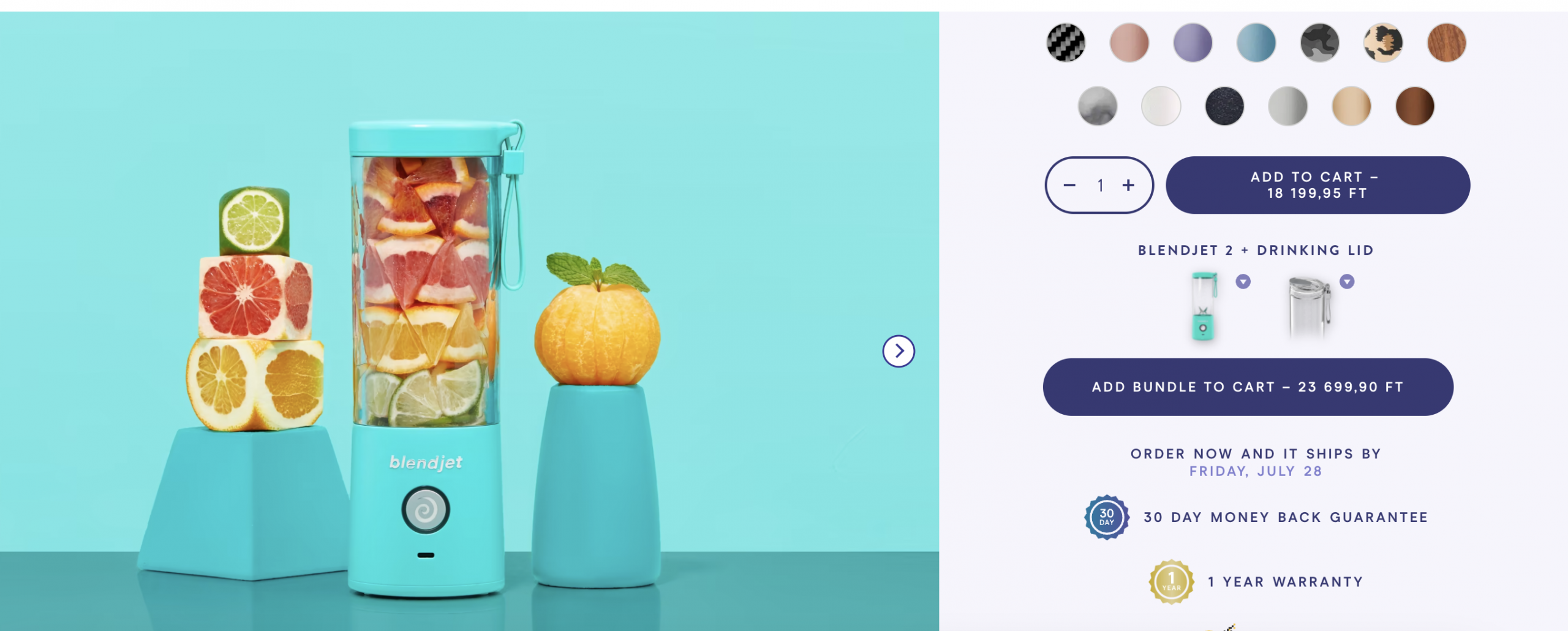
BlendJet is a D2C brand that sells on-the-go smoothie makers to a target audience of busy, health-conscious people.
There are many reasons we love BlendJet’s product page, including the visually-appealing product photos and the way they use the perfect tone of voice for their site visitors.
However, we’d like to highlight their great use of trust badges and the way they promote their free returns offer.
What can you learn from it?
Potential customers who have never encountered your brand can be suspicious about the trustworthiness of your site and the quality of your products.
Displaying trust badges on your product pages can help build credibility with these site visitors. Similarly, a strong money-back guarantee helps customers decide to make a purchase without worrying about whether they’re really going to like the product once it arrives.
See how BlendJet generated 39.2% extra revenue with OptiMonk.
2. Obvi
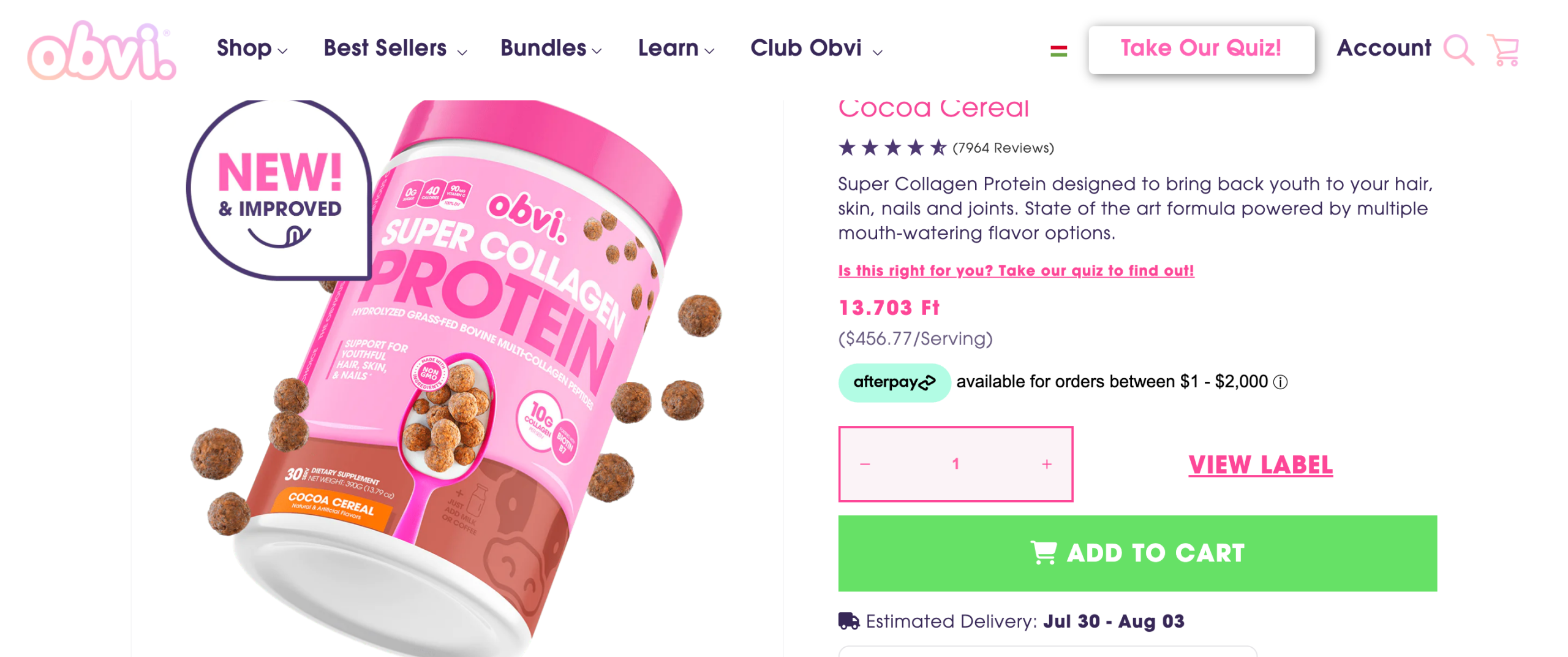
There’s a lot to love on Obvi’s product page: it’s easy to navigate, it has great product images, and it displays shipping information like estimated delivery time.
Showing estimated delivery can be really helpful for customers because it lets them know whether a product will arrive in time for when they need it.
Here, though, we’d like to highlight the quiz that Obvi promotes on their product pages, which aims to help potential customers figure out if the product they’re viewing is right for them.
What can you learn from it?
Quizzes enhance the on-site experience and help customers find ideal products. Plus, they’re fun!
Obvi’s quiz for its “Super Collagen” protein powder allows first-time visitors to discover the best product for them by entering details like gender, size, and workout goals. Furthermore, utilizing the quiz data allows Obvi to personalize future communications, which is highly valuable.
If you’d like to create a short quiz for your own online store, you can get started with these templates:
3. Glossier
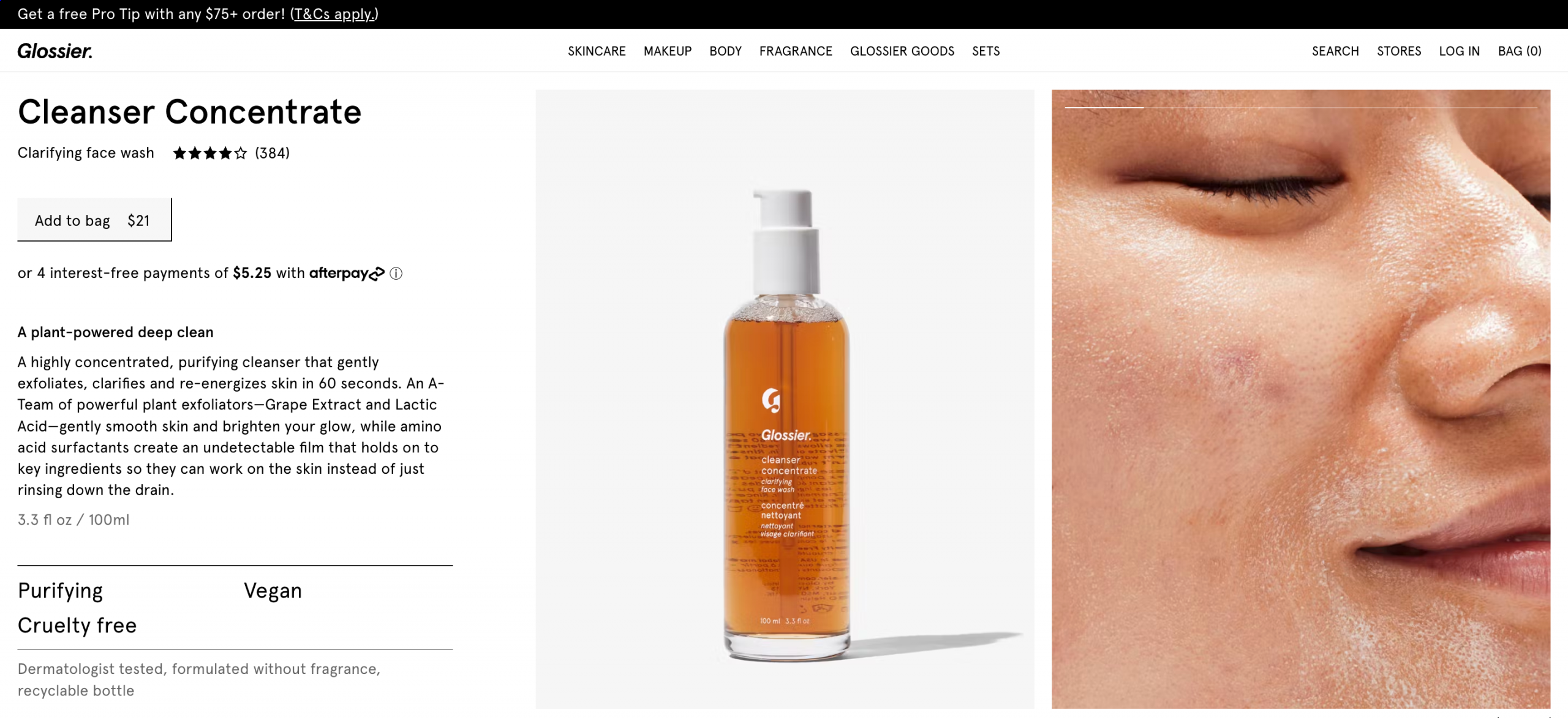
Glossier is a popular beauty brand that focuses on minimalistic, natural-looking makeup.
Their product pages feature clean and simple designs, as well as very detailed descriptions of how to use each of their products. This not only helps online shoppers with product comparison, but also helps establish their brand voice as authoritative about their niche.
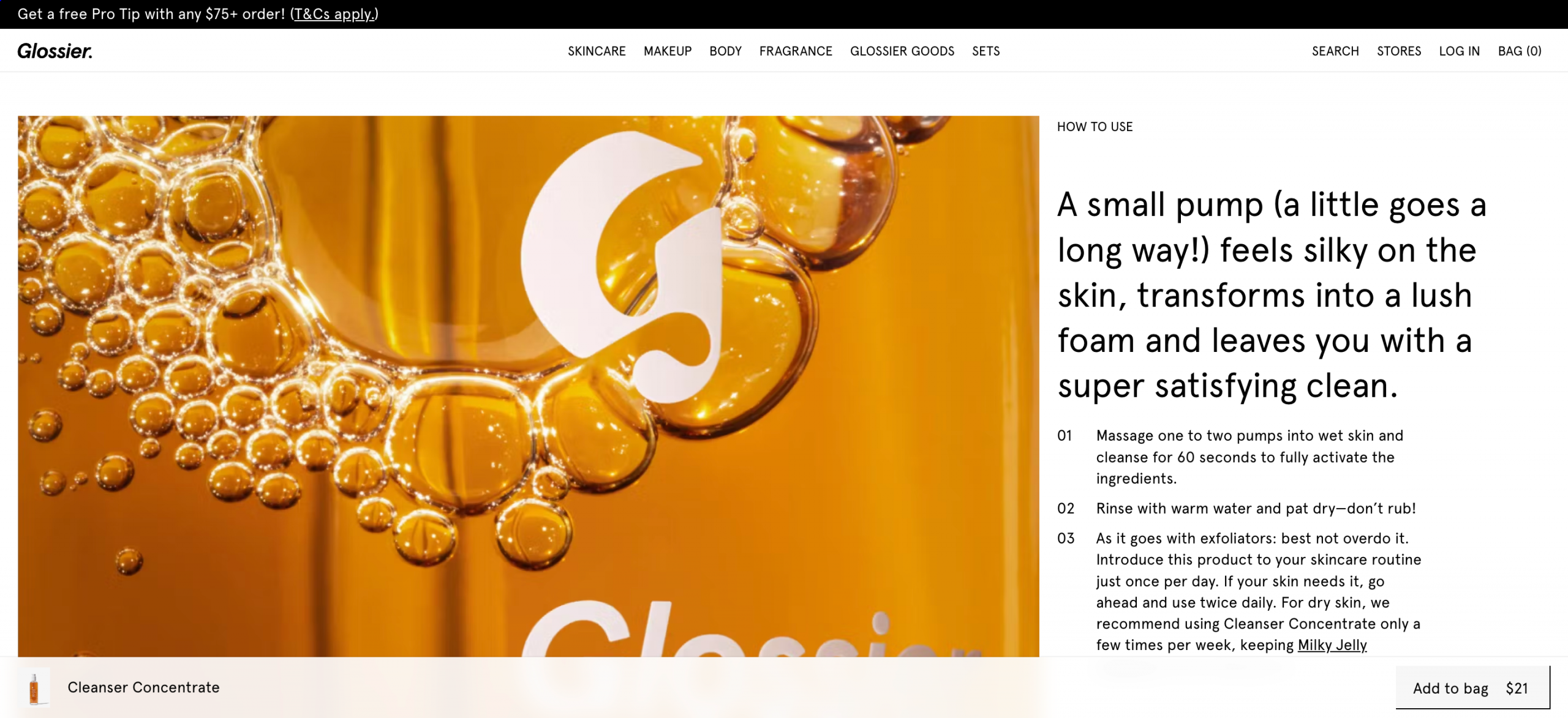
What can you learn from it?
You should never assume that your target audience is already knowledgeable about your products or even your product category.
Many customers need to see a lot of product details to know whether they’re interested in a product, which means key features need to be explained in a way that all your visitors will understand.
Product page descriptions are a great way to introduce new website visitors to your niche and to establish your value proposition.
4. Spanx
Online stores face the challenge of providing a shopping experience that compensates for the inability of customers to interact with products physically.
Spanx—a popular brand known for shapewear and undergarments designed to provide comfortable support and enhance body confidence aims to replicate the in-store experience through their product pages by offering guided selling and personalized content.
Check out what Spanx does in more detail.
Like many of the ecommerce product page examples we’ve seen, Spanx offers multiple product images and product videos. This helps customers understand how the product will look like in real life.
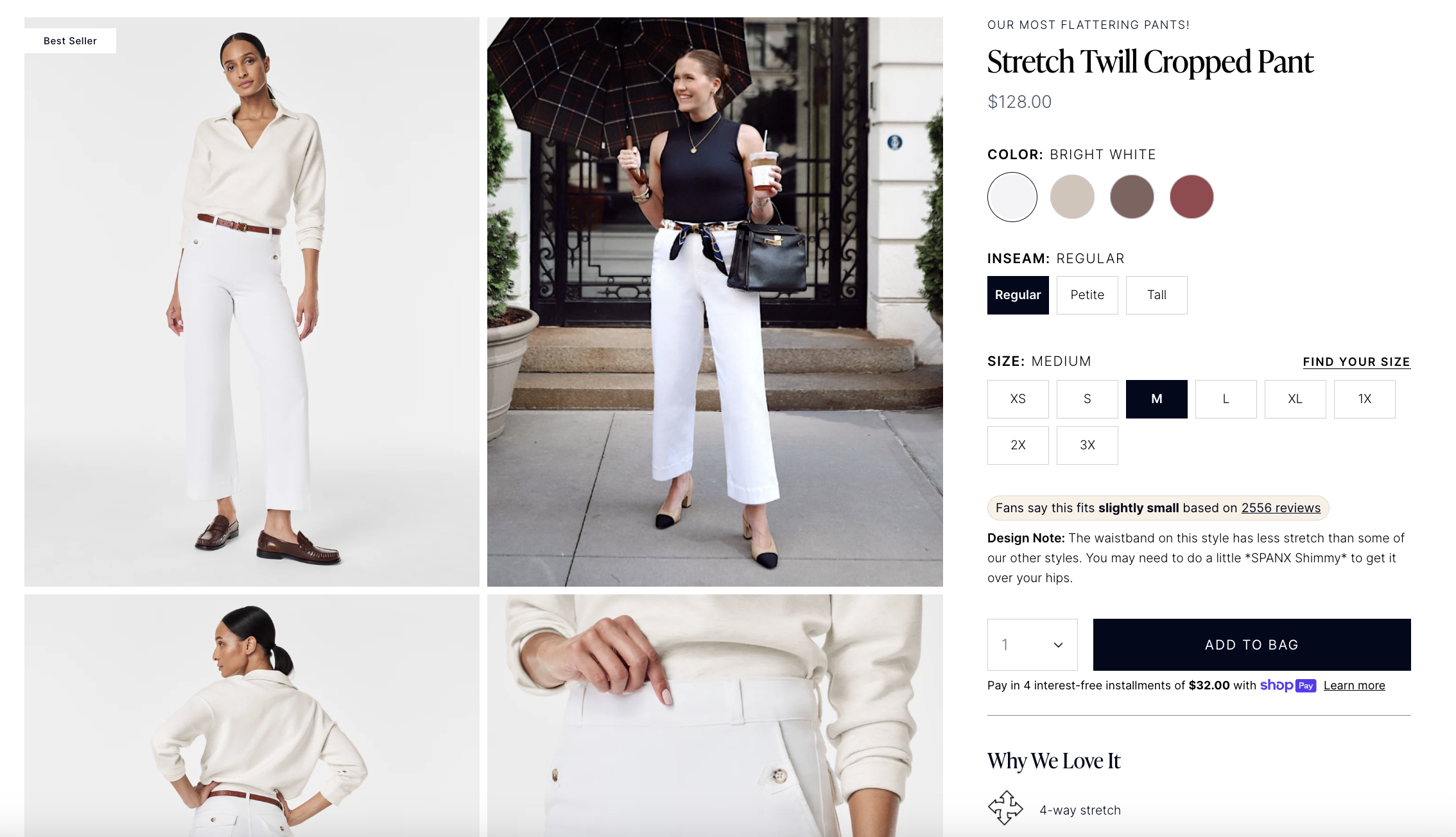
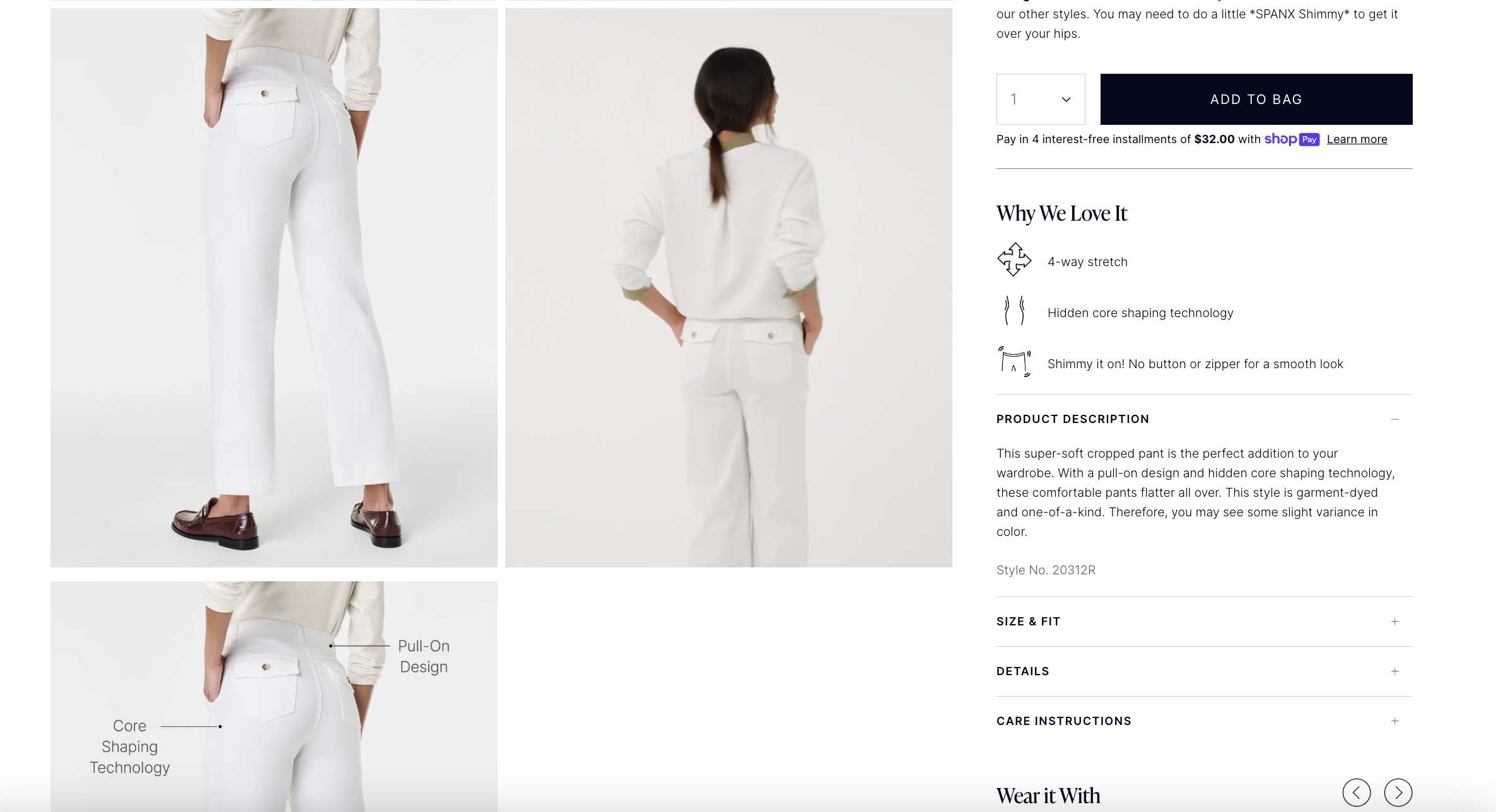
But that’s not all! When a shopper is uncertain about the size of a product, they can use the “Find your size” link.
Moreover, Spanx highlights extra information like “Fans say this fits slightly small” or “Design note,” which offer valuable insights into the product’s fit and stretch.
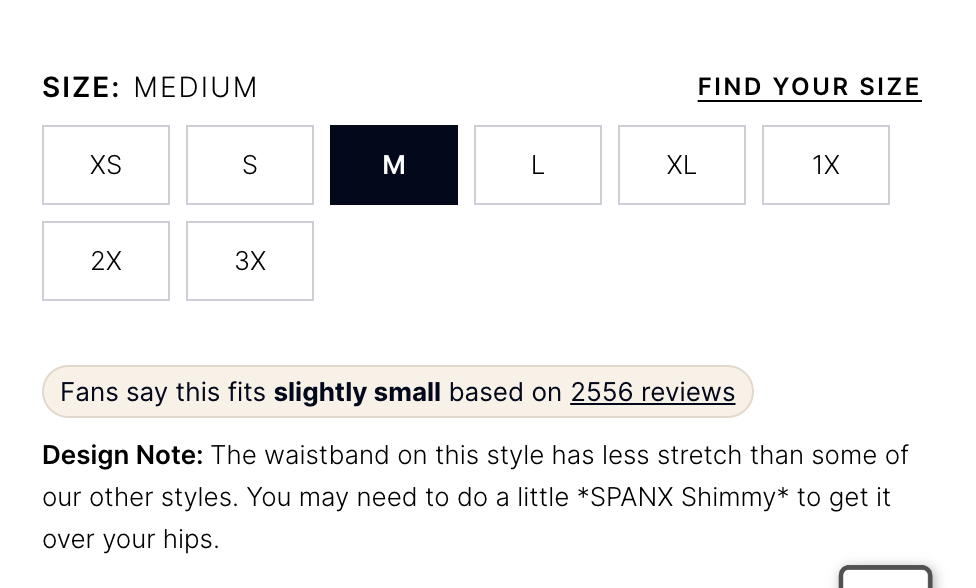
They also have a dedicated Size & Fit section offering detailed information.
By presenting this information prominently on the product page, Spanx ensures that customers have all the necessary details at their fingertips.
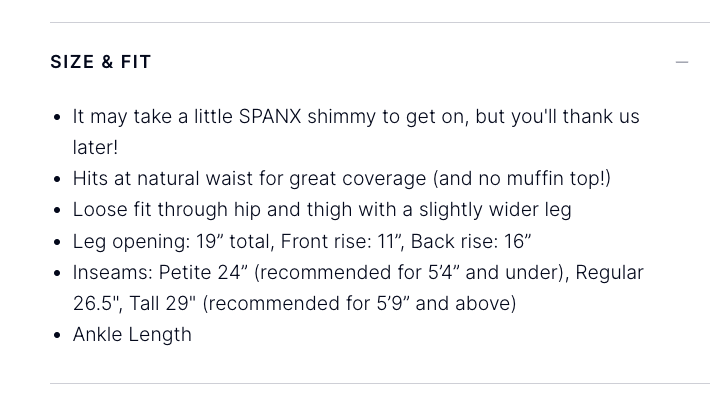
Understanding the influence of social proof in purchase decisions, Spanx also added an “As seen on social” section to their product pages.
This section curates user-generated content showcasing real customers wearing the product which helps customers visualize it on themselves.
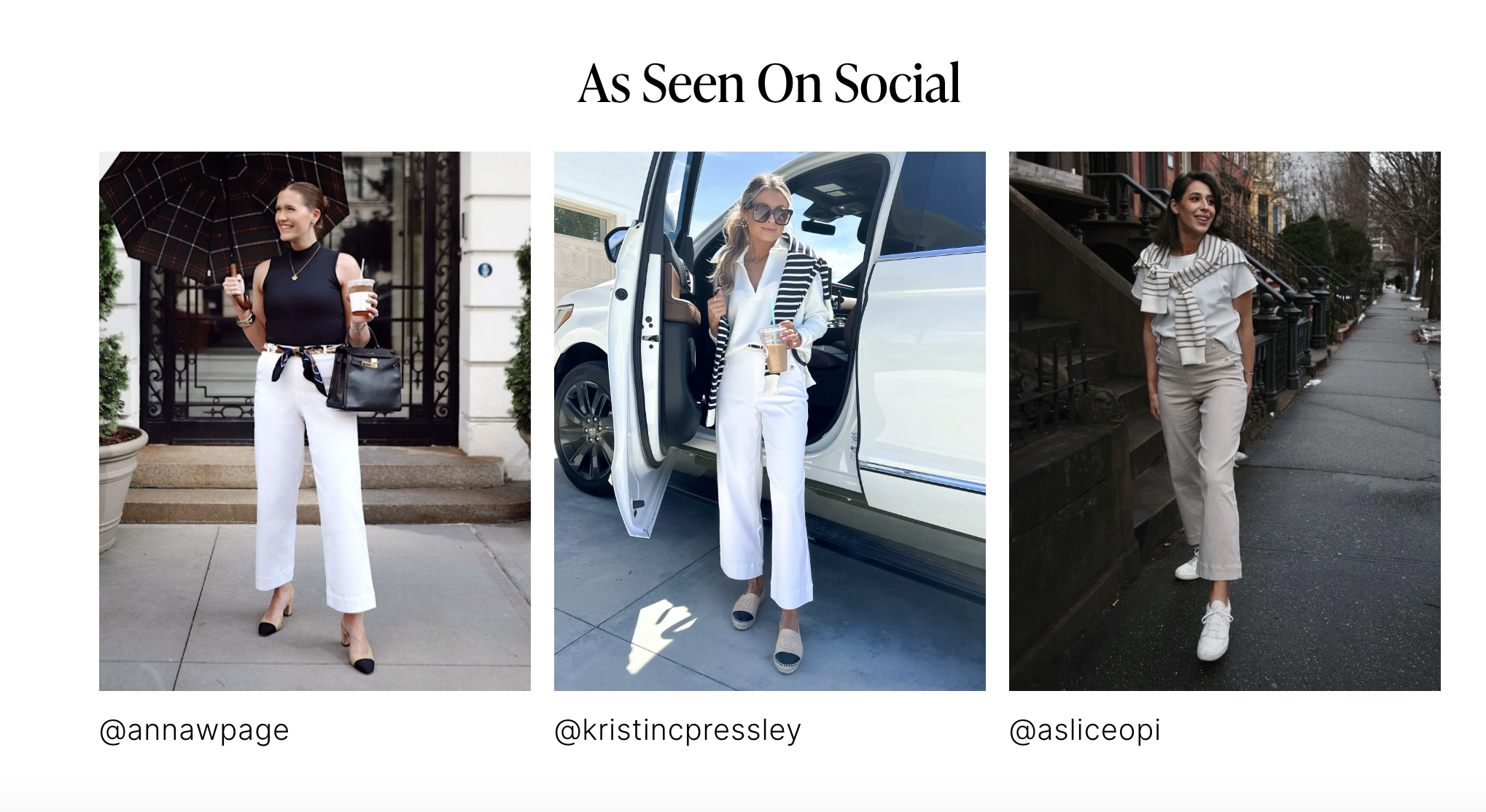
By integrating these tools, Spanx ensures that their customers make purchases they are confident about and satisfied with.
What can you learn from it?
One of the main challenges you face as an online shopper is predicting how a garment will look on you when it arrives. Presenting products with high-quality product photography and adding detailed product descriptions help visitors feel confident they won’t be disappointed with their purchase.
5. MyProtein
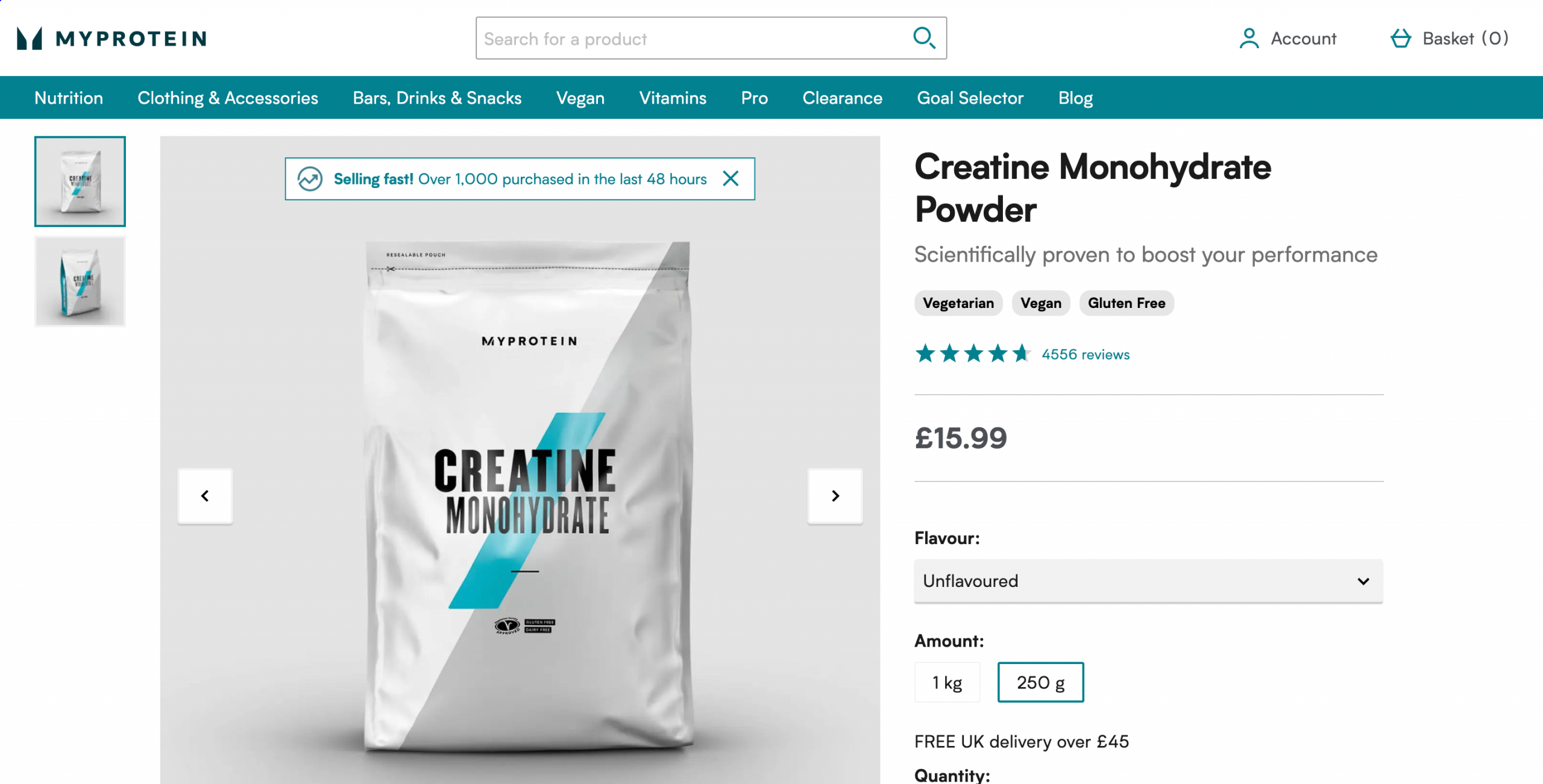
Myprotein is a popular sports nutrition brand known for its high-quality protein supplements, sports supplements, and fitness-related products.
Their product pages feature videos that explain the benefits of their products. Like other health-focused brands, they know that they need to provide plenty of high-quality information to their potential customers.
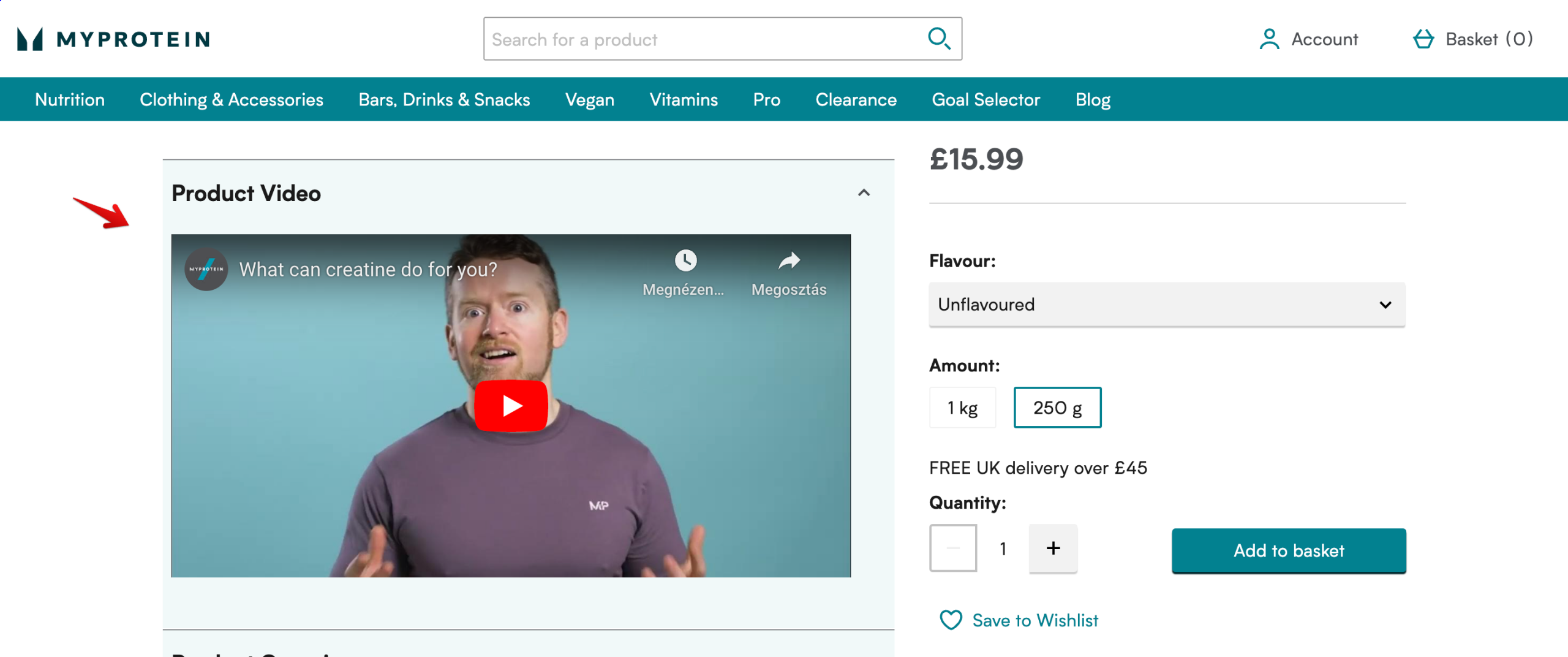
What can you learn from it?
Having a detailed product video on your product page can help your visitors understand your product better. Video is also a very engaging format, and it means your customers don’t need to read a huge block of text to get the information they need.
6. Dollar Shave Club
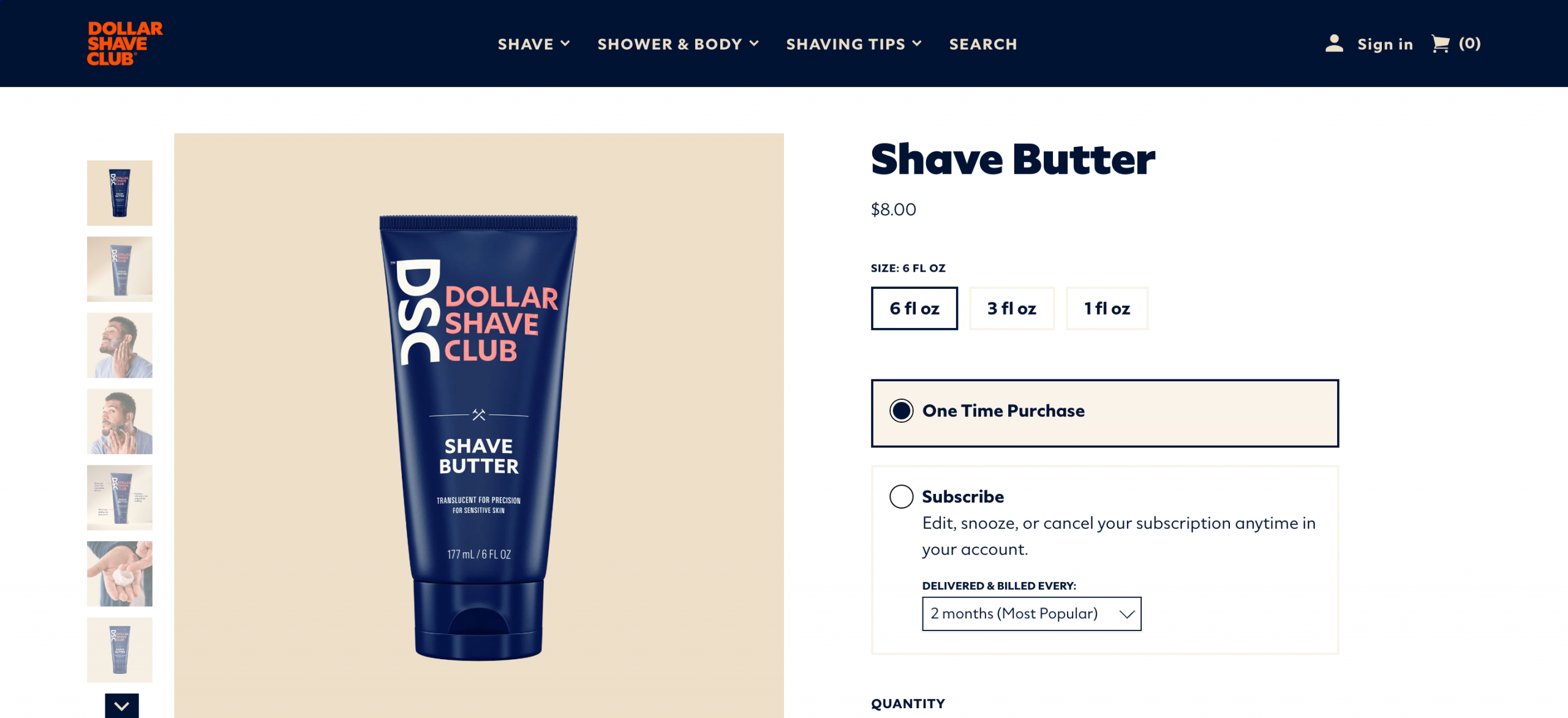
Dollar Shave Club is a subscription-based grooming brand that helped establish the subscription model in the D2C space.
On their product pages, they really emphasize the convenience of their customizable subscriptions for razors and other grooming products. Instead of making a one-time purchase, they advise customers to sign up for a regular subscription.
Additionally, they offer complementary products at the bottom of each of their product pages.
This is an excellent cross-selling tactic that encourages visitors to add more items to their order, upping the convenience and helping customers save on shipping costs. It also allows customers to easily buy complementary items without needing to navigate away from the current page.
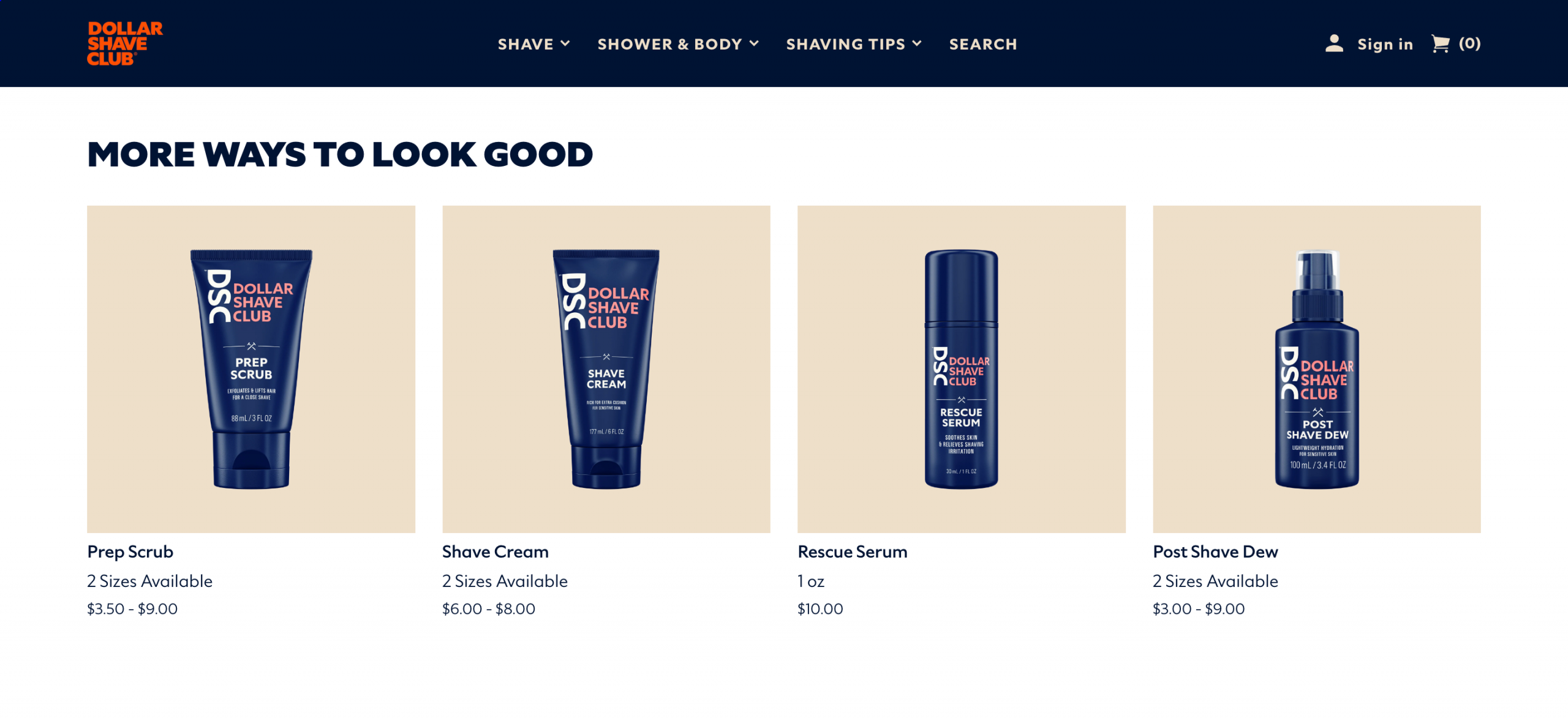
What can you learn from it?
Your product page is a great place to highlight your upgrades and complementary products. Many ecommerce stores use this strategy to increase the average order value, which can provide a boost to overall revenue and profits.
Read more about Dollar Shave Club’s marketing strategy here.
7. Lululemon
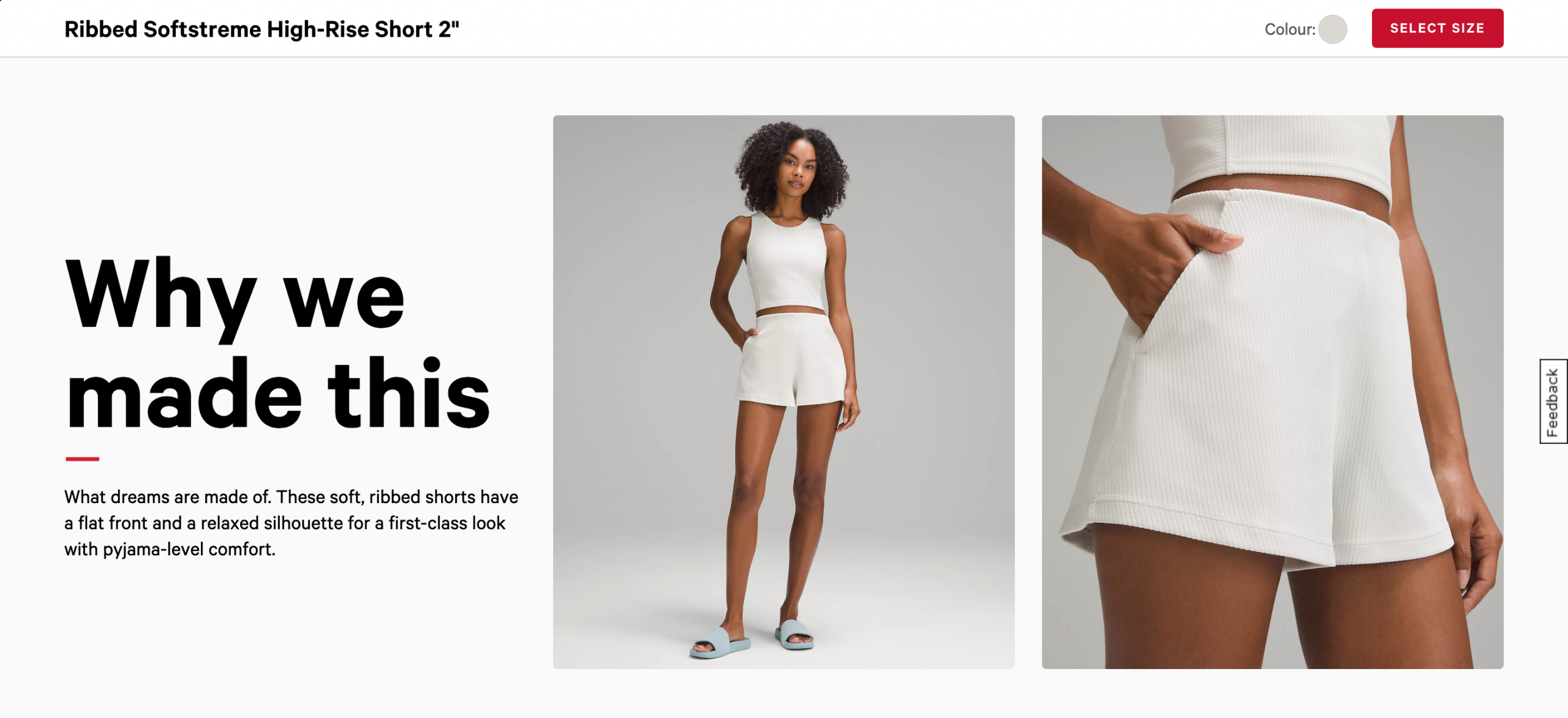
Lululemon has become famous for their high-quality yoga and athletic garments, as well as other activewear products.
On their product page, they highlight all the shipping details that users need to know (including the in-store pickup option). They also prominently feature their free shipping offer, which helps convince customers to make a purchase.
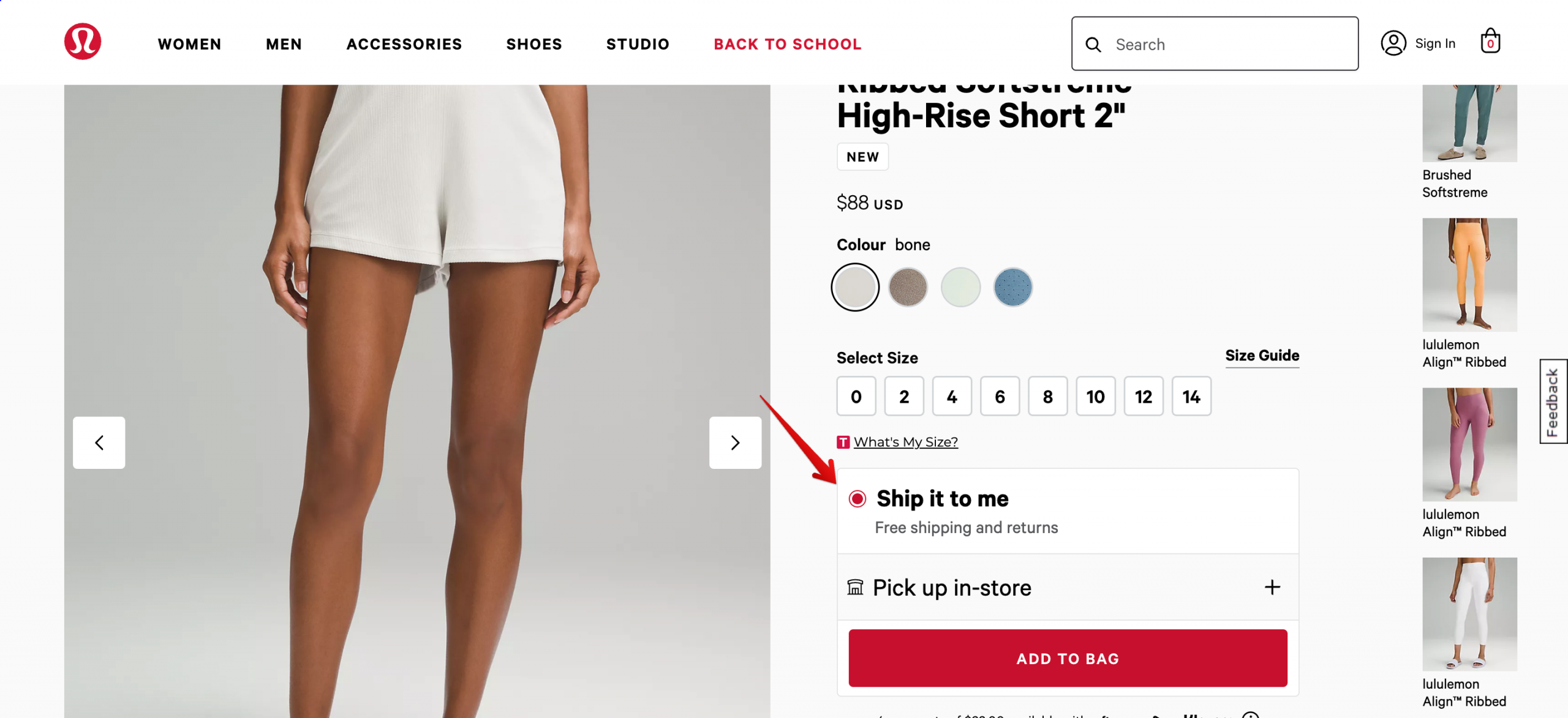
What can you learn from it?
When selling products online, studies have shown that free shipping is one of the most powerful incentives for most users. Ecommerce businesses that help users avoid high shipping fees can expect to see a lot of success.
By displaying a sticky bar on all your product pages, you can make sure that every visitor knows about your free shipping threshold:
8. Warby Parker
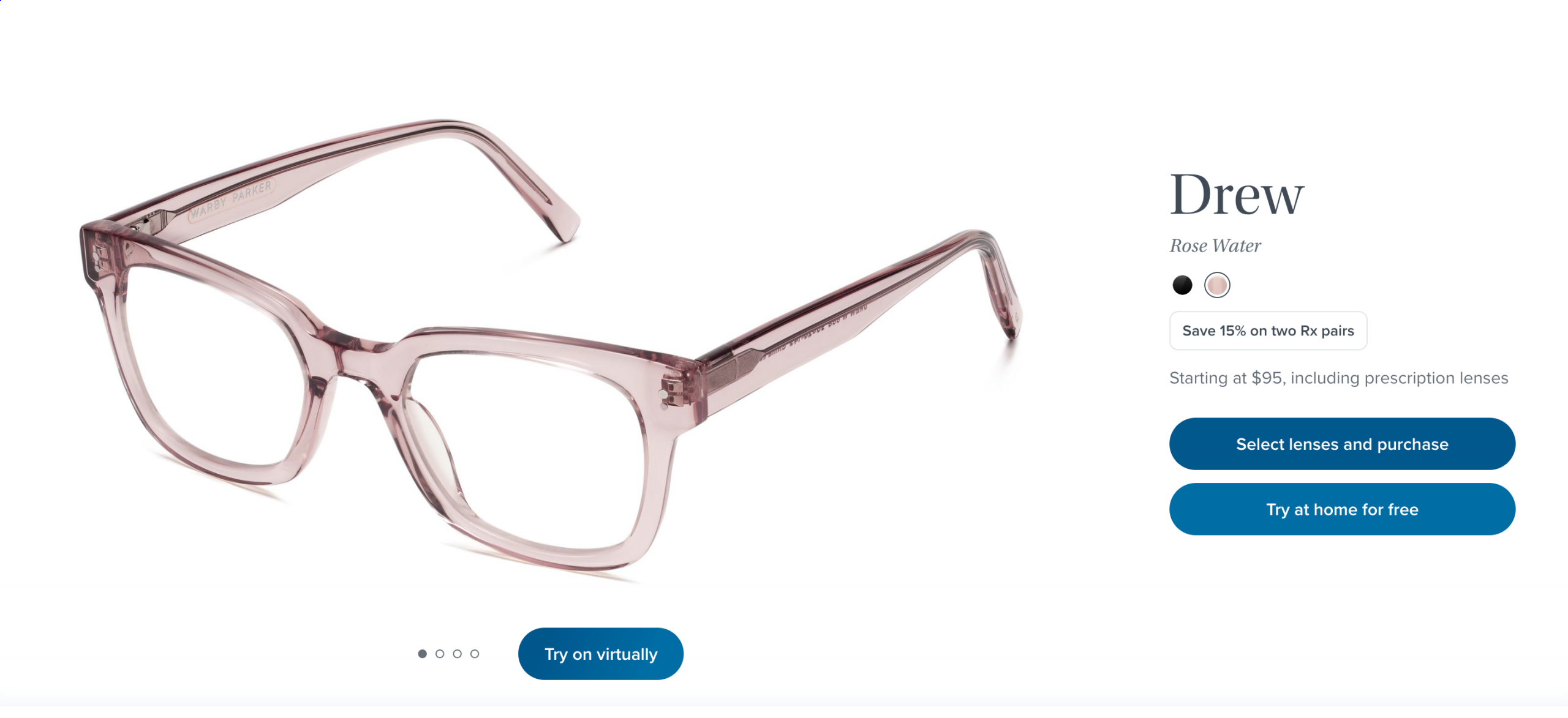
Warby Parker is a D2C eyewear brand that’s had a lot of success with their innovative “Home Try-On” program, allowing customers to try multiple frames before making a final purchase.
They also offer virtual try-ons on their product pages.
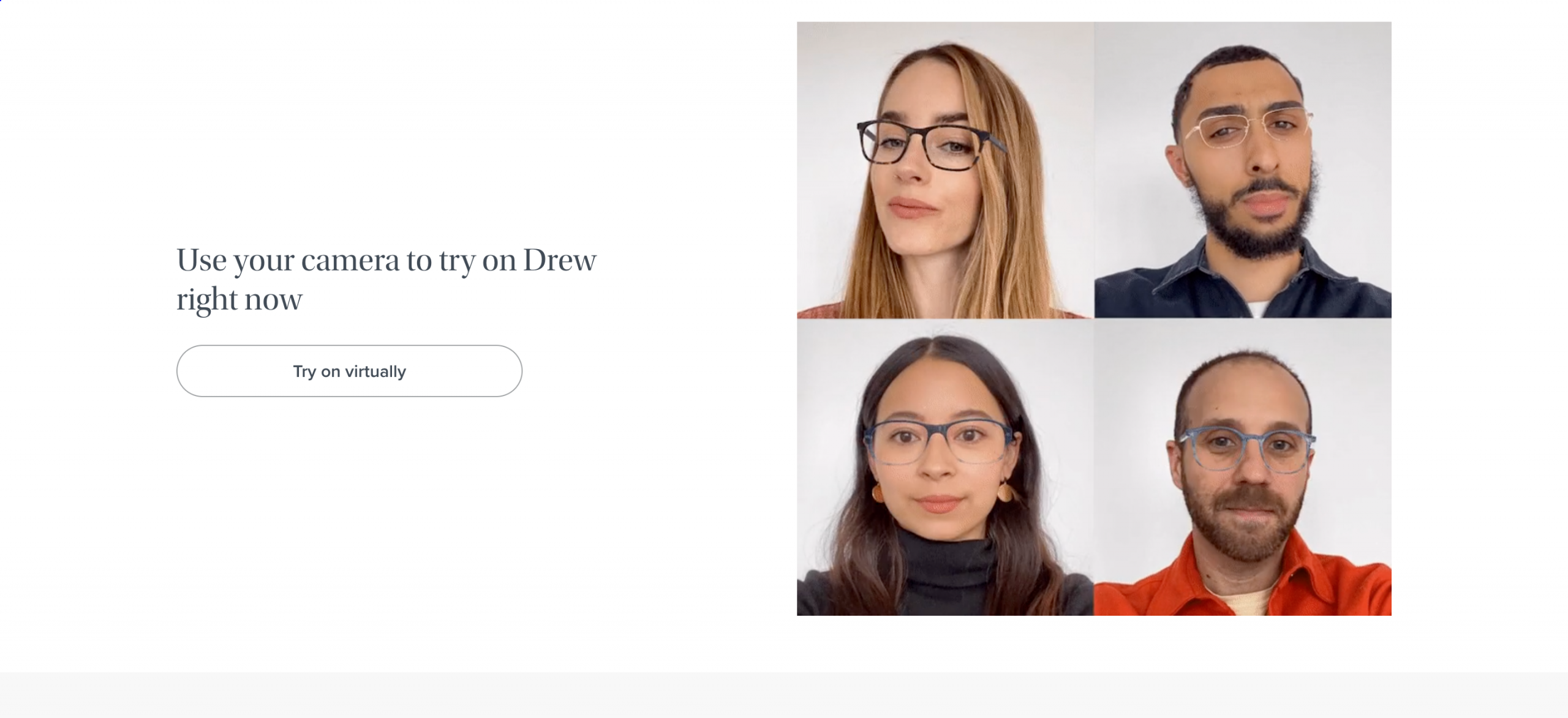
What can you learn from it?
When you create product pages that give your customers a sense of what your products will look like in real life, you’ll have a lot more happy customers and a much lower return rate.
If the virtual try-on concept won’t work for you, you could try using animated images to give customers a better understanding of what your product looks like and how it performs.
9. Casper
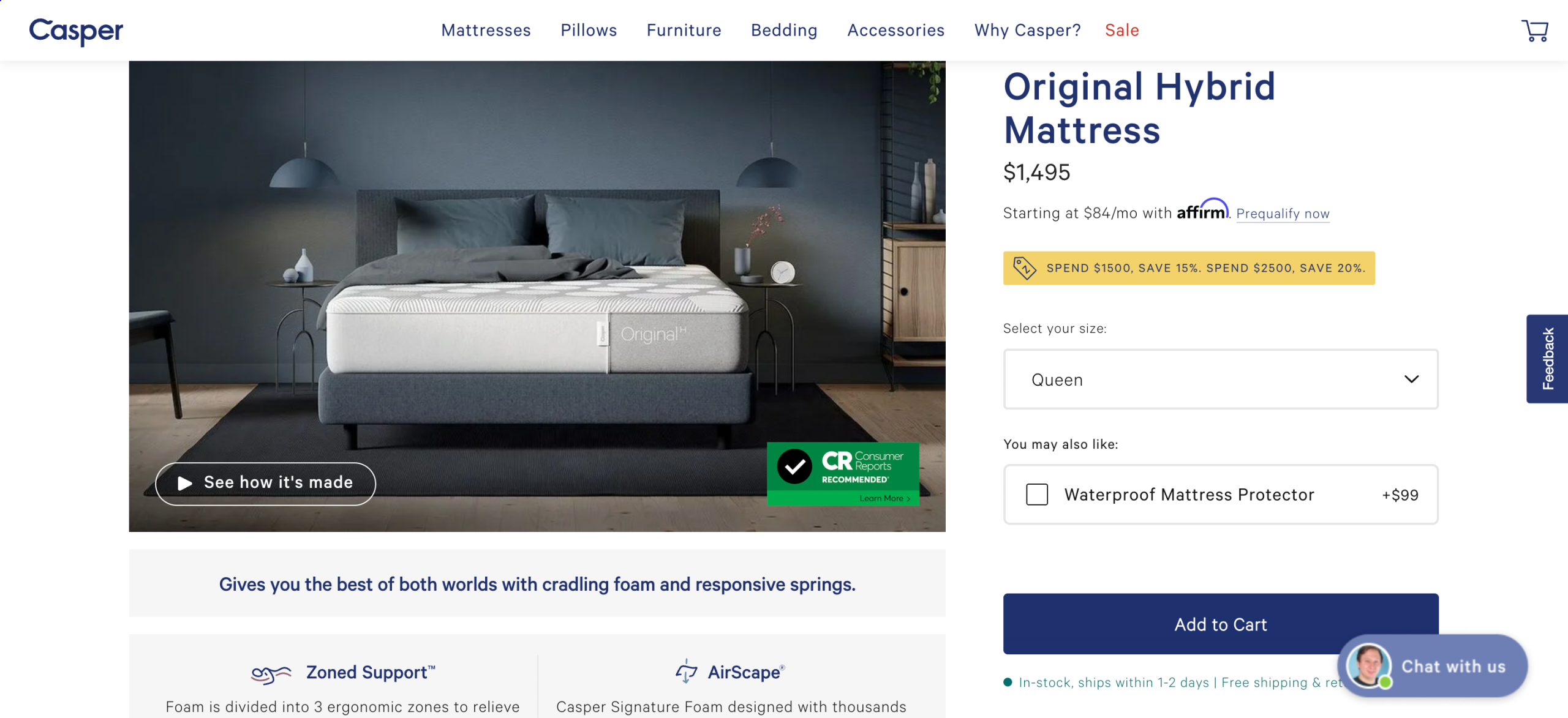
Casper is a well-known mattress and bedding company. Their product pages feature informative details about the materials used and their sleep technology. They also promote their “100-night trial” offer and include upsell offers underneath the size button.
Crucially, they also provide plenty of social proof in the form of ratings and customer testimonials.
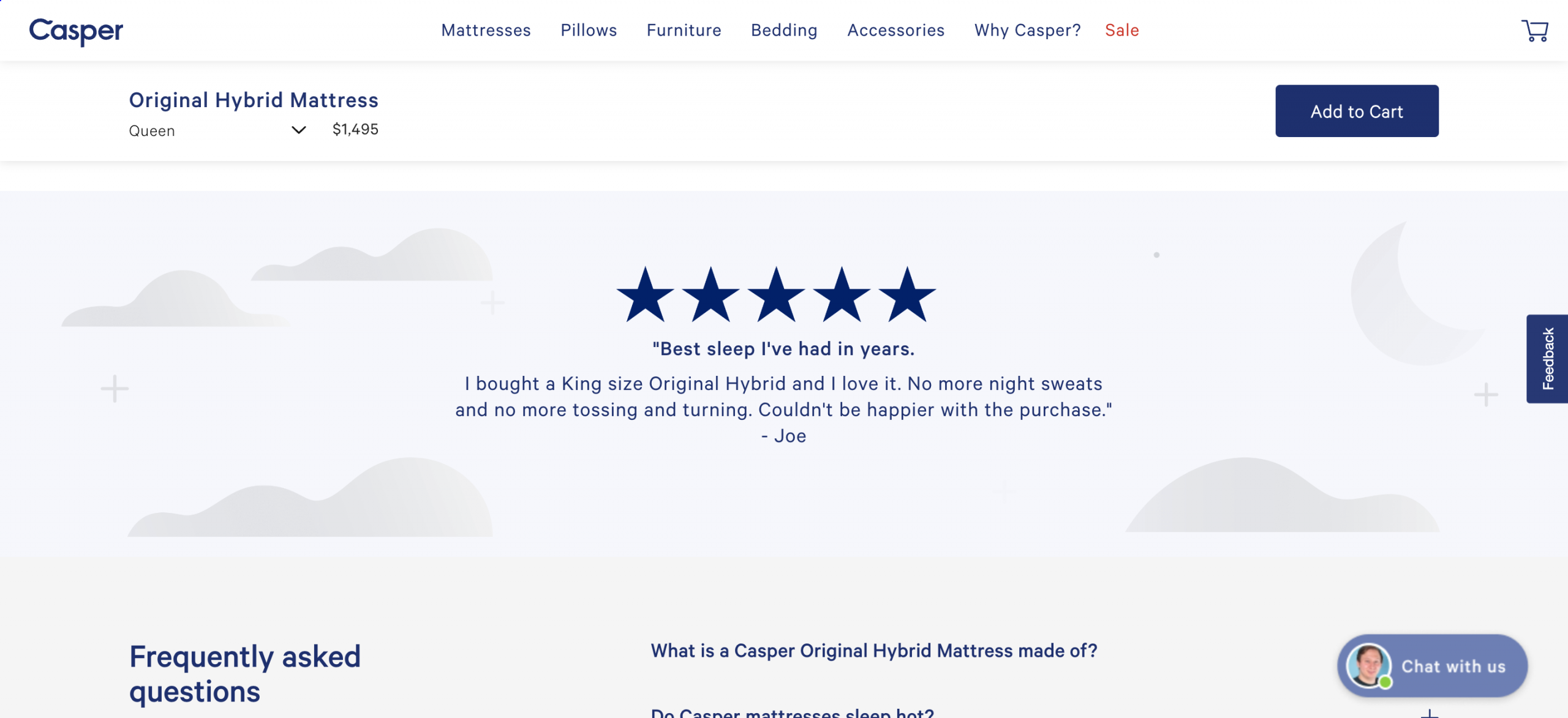
What can you learn from it?
Sharing customer feedback that casts your products in a good light is a great way to increase your credibility among first time customers. After all, these customers don’t have any experience with your brand, so they don’t know whether to trust what you say about your own products.
However, featuring what your customers say about you on your product pages can help address these concerns.
10. Peloton
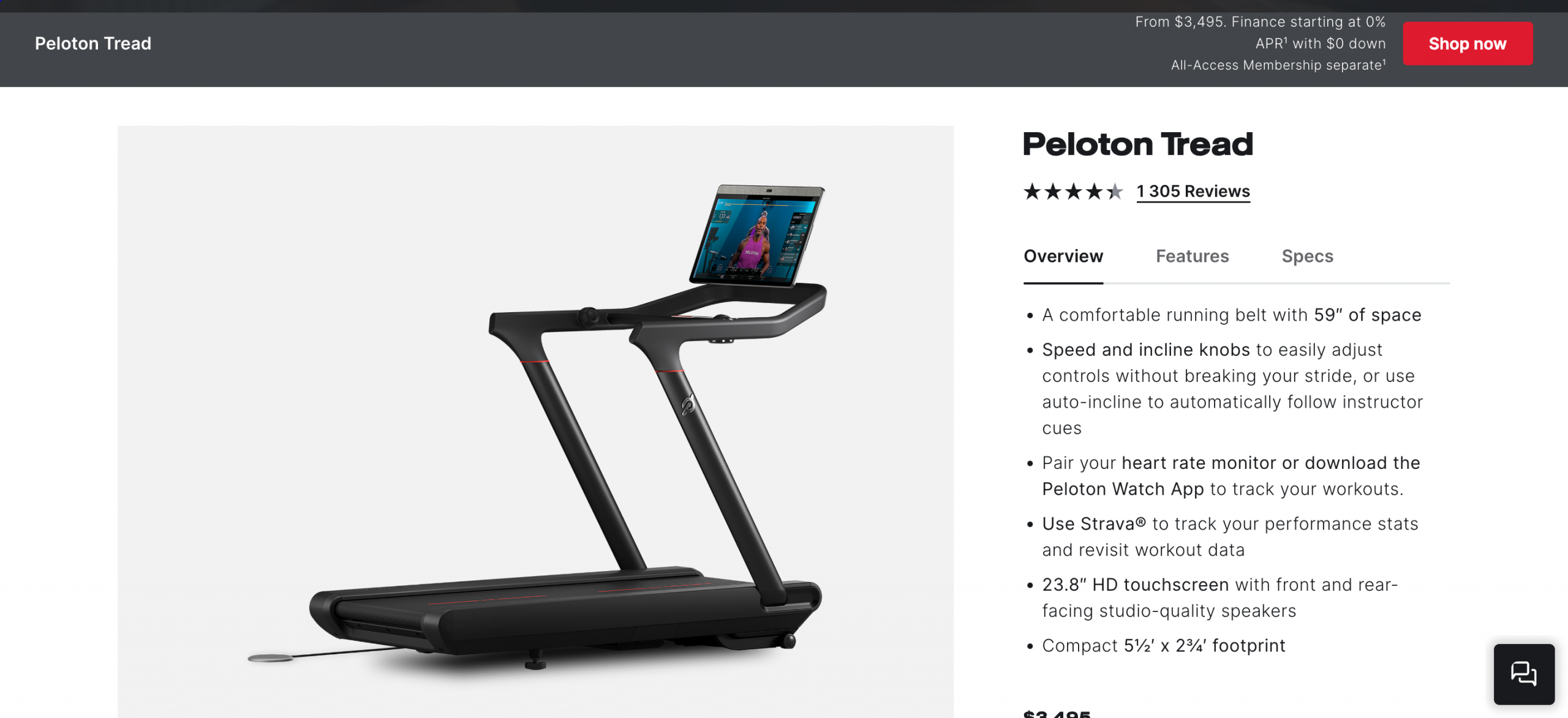
Peloton offers connected fitness equipment and interactive workout experiences. Their product pages emphasize the extra features that come with their products, such as live classes and virtual running experiences.
Like Casper, you can see that they feature customer reviews at the bottom of their product pages.
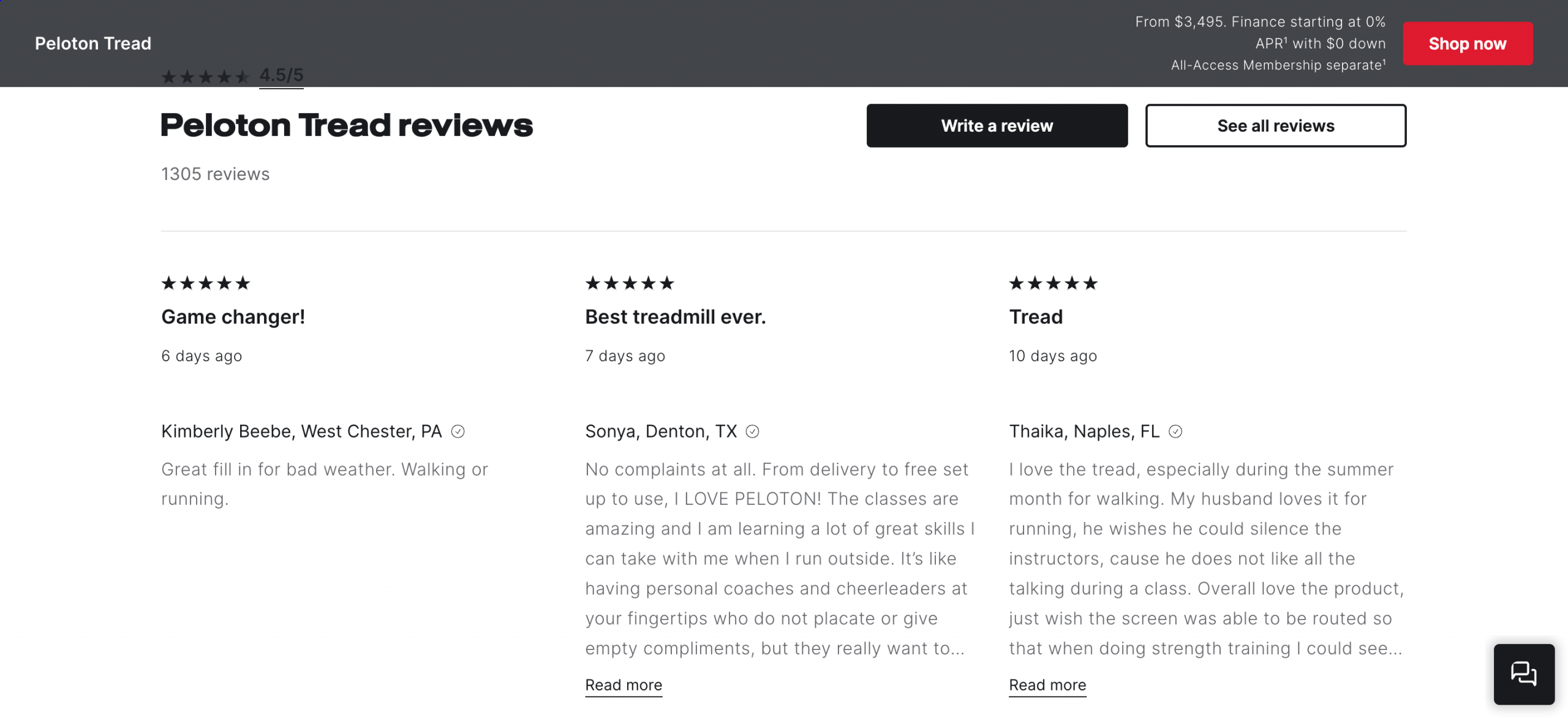
What can you learn from it?
Showing multiple reviews like Peloton does can add even more credibility to your brand. When your visitors can really tell that they’re reading authentic reviews, they’ll pay a lot of attention to them.
11. Fenty Beauty
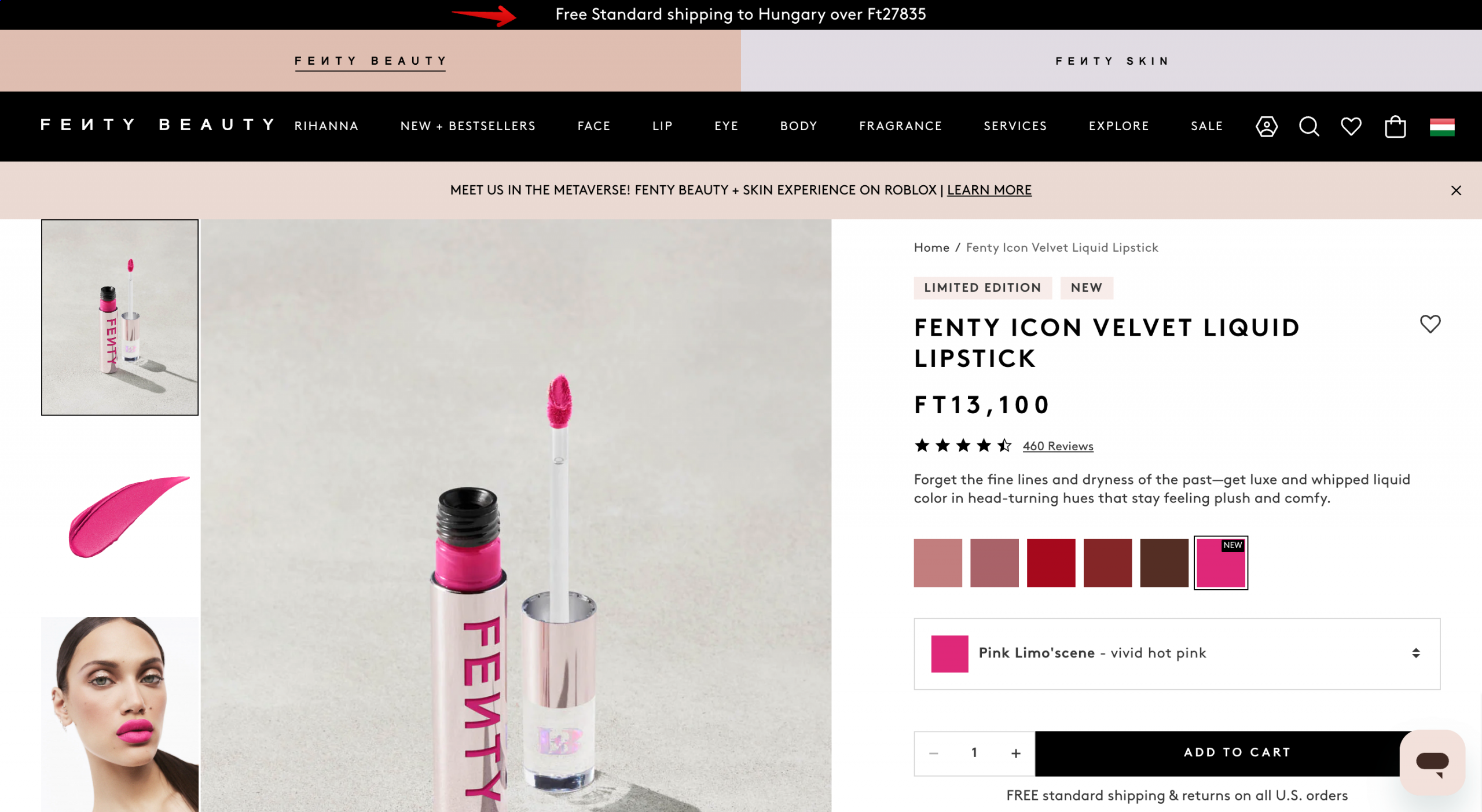
Fenty Beauty, founded by Rihanna, is a trendy, inclusive makeup brand known for its diverse range of shades and high-quality products.
Their outstanding product page ticks a lot of the product page boxes we’ve gone over so far, including displaying international shipping information and showing lots of close up shots of the product.
We’d like to highlight the comparison section that Fenty Beauty features on their product pages, which allows customers to compare the products they’re currently viewing with other popular products.
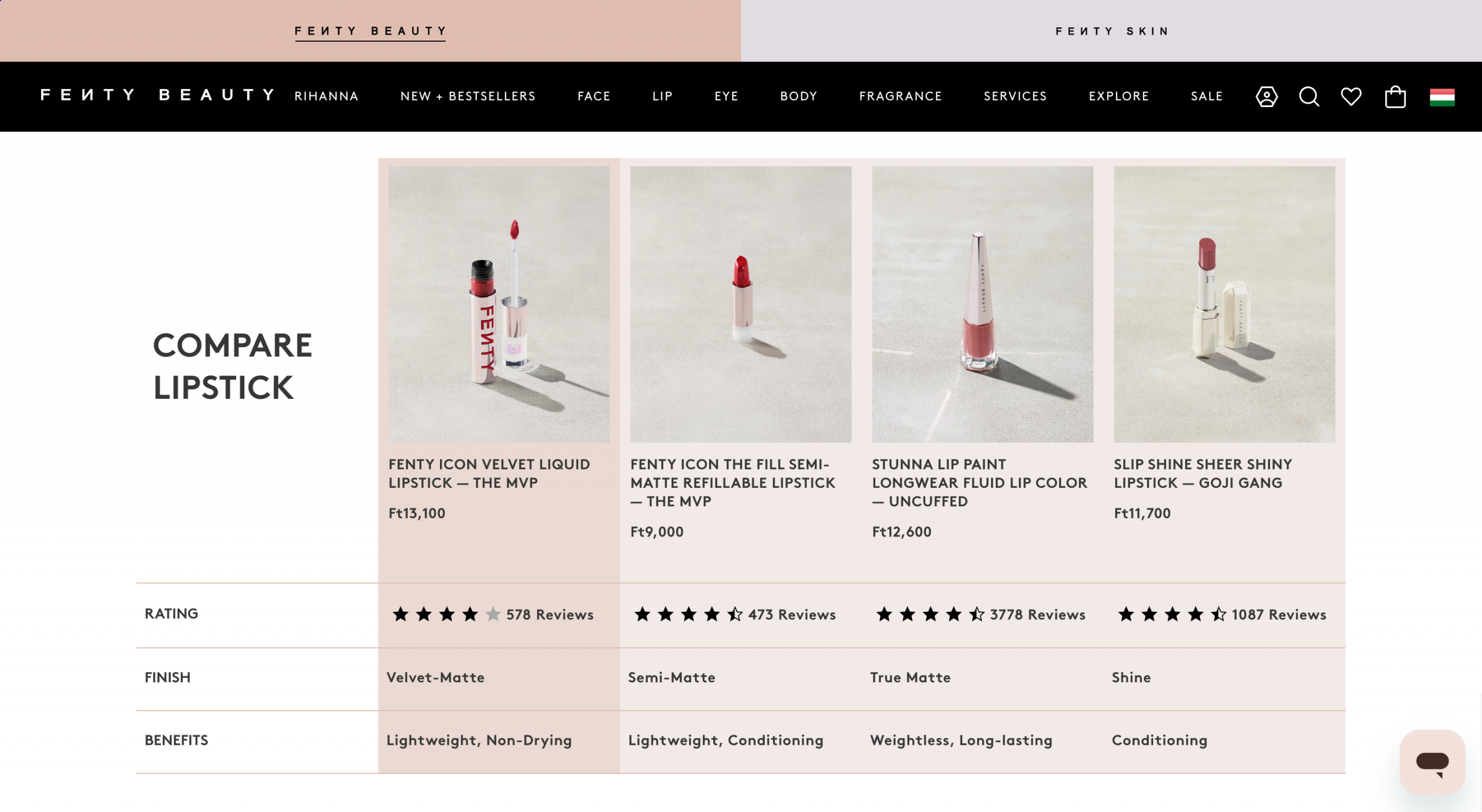
What can you learn from it?
When you’re figuring out your product page layout, it’s a good idea to help your visitors compare the different options you offer. You’ll have an easier time building a loyal customer base if everyone who’s shopping can find the product that suits them best.
12. Nike
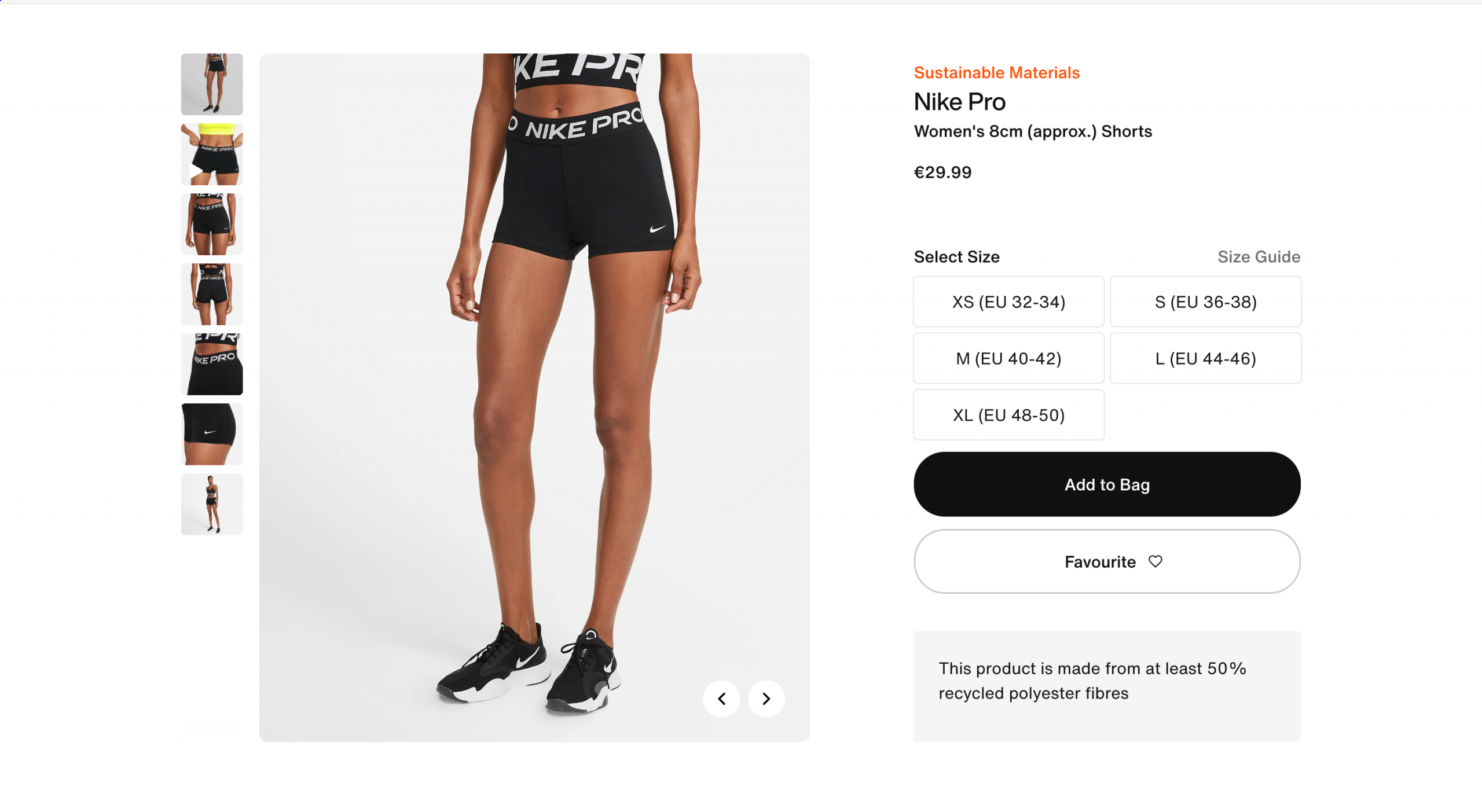
Nike is an iconic sportswear brand. Each of their dynamic, user-friendly product pages has been designed to cater to athletes, fitness enthusiasts, and casual wearers alike.
It should come as no surprise Nike has a lot of user-generated content available to use on their product pages. They feature engaging UGC from a diverse range of individuals, from professional athletes to hobby sports enthusiasts.
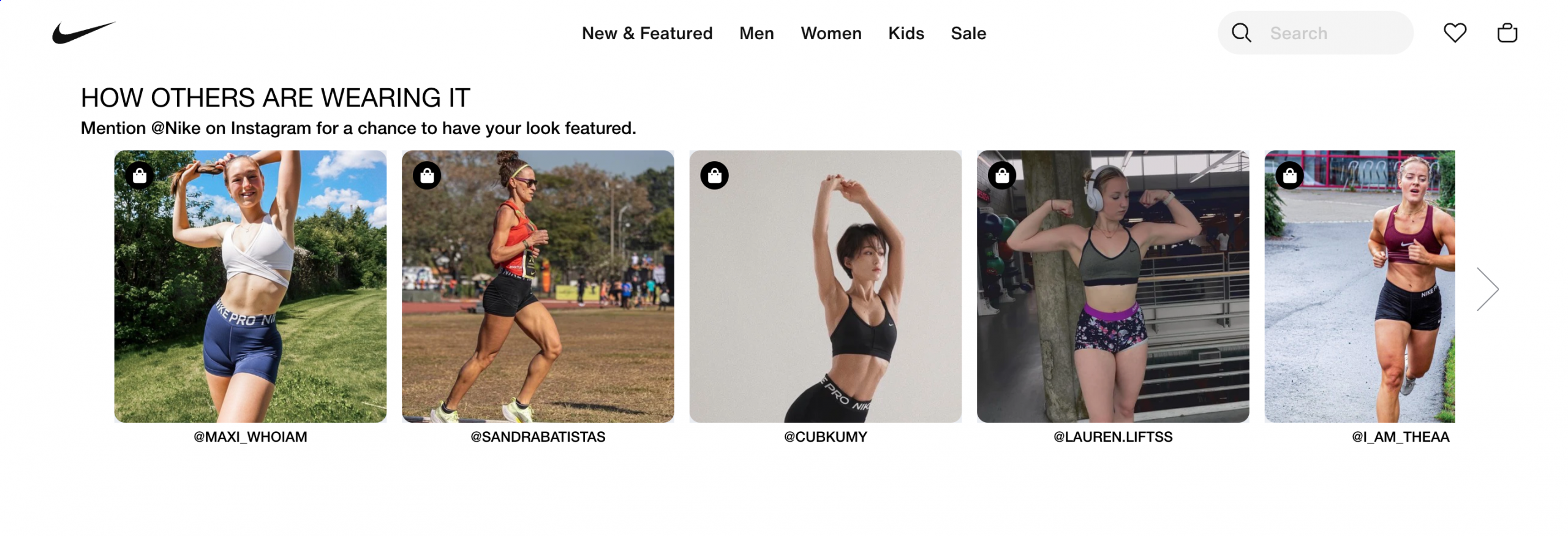
What can you learn from it?
User-generated content and lifestyle photos can function as powerful social proof and give your customers a better idea of what your products will look like in real life.
13. Allbirds
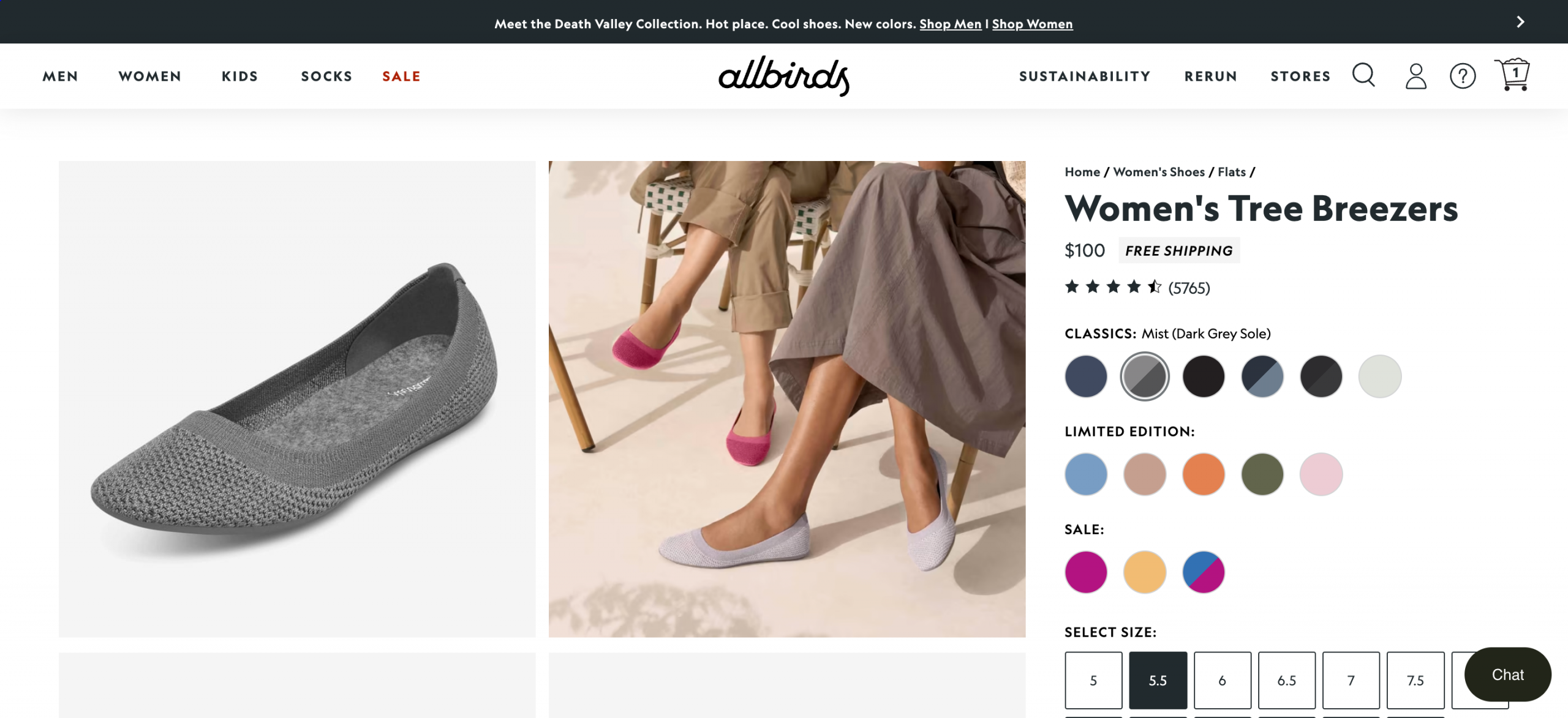
Allbirds is a popular footwear brand that gained widespread recognition for its commitment to sustainability and eco-friendly practices.
Their product pages are unique because they update to display complementary products after the product is added to the cart.
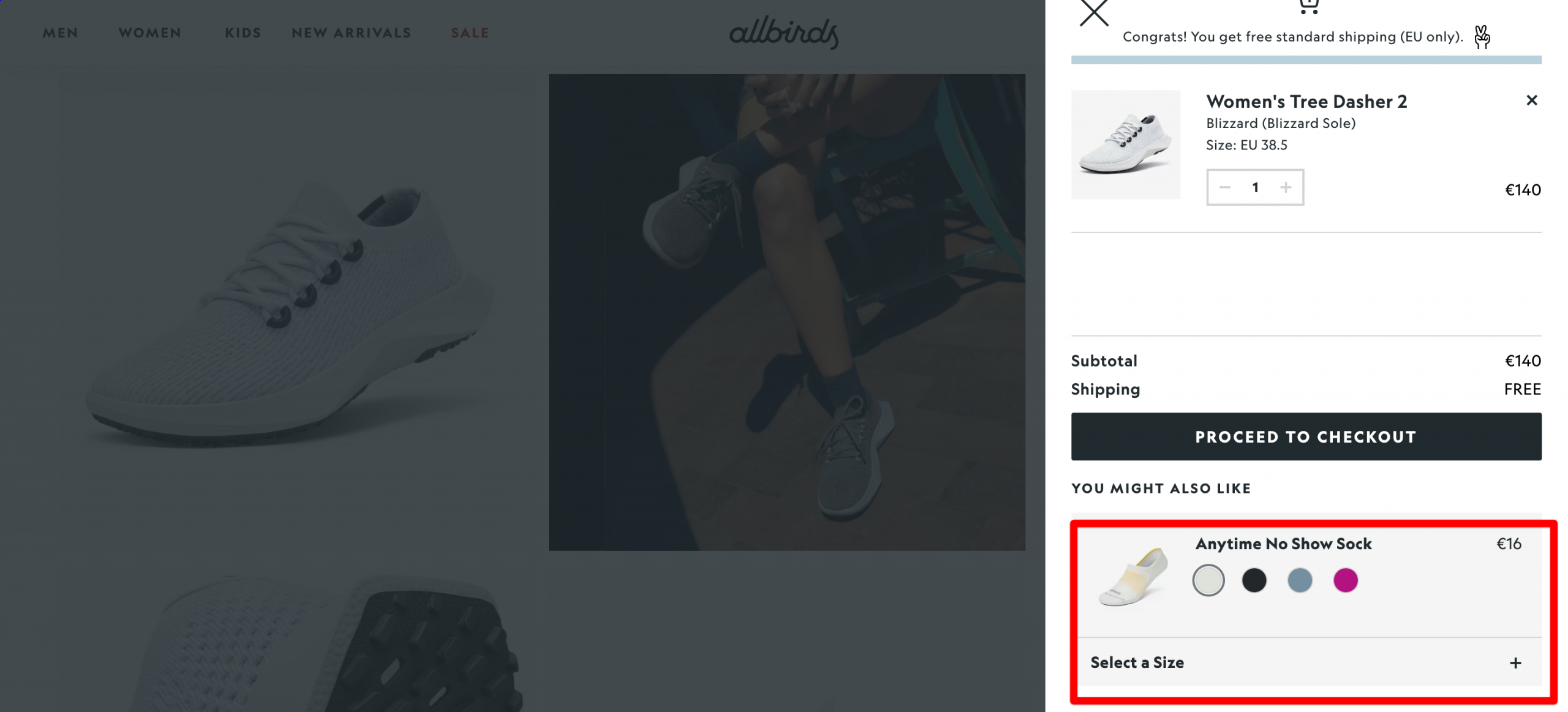
What can you learn from it?
You can increase your average cart value by offering complementary products while the customer is checking out. This is a great time to make a cross-selling offer because your customers are excited about their purchase and will most likely be receptive to your offer.
14. Gymshark
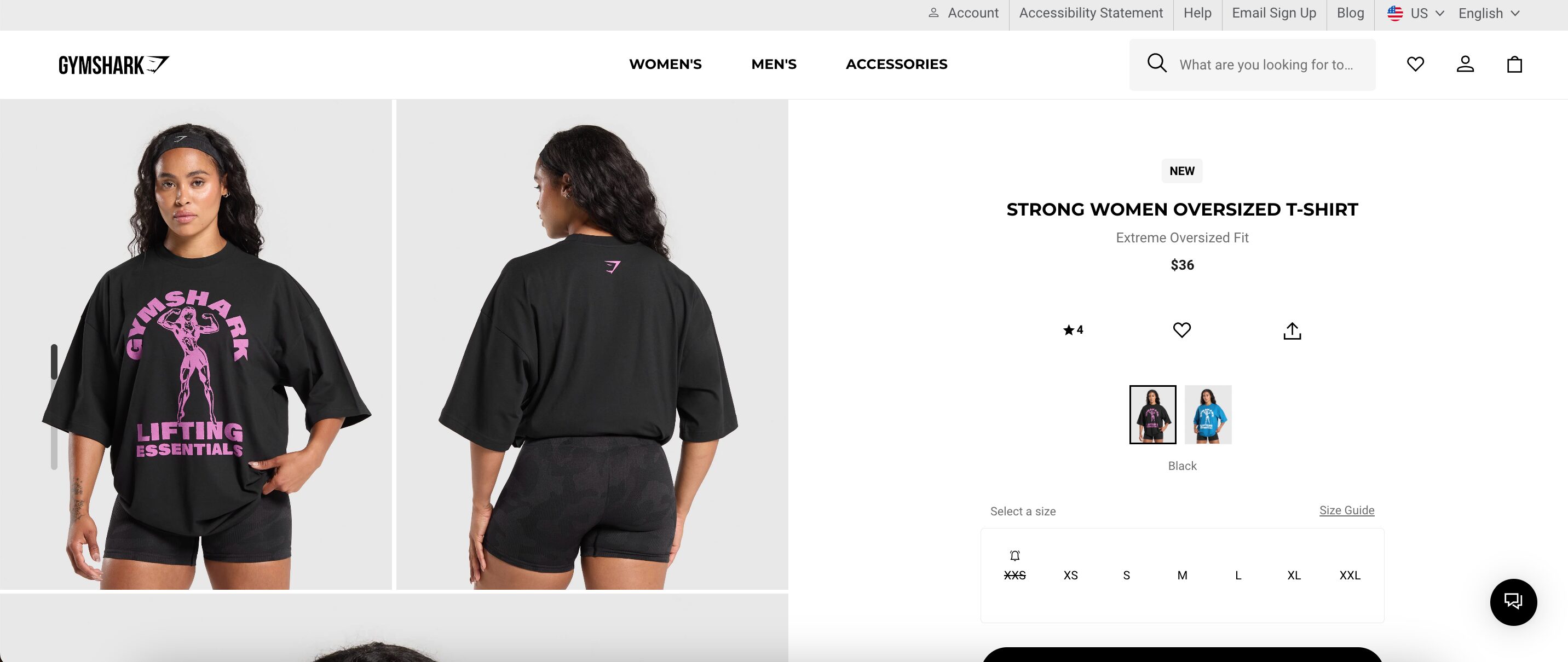
Gymshark excels at creating a highly visual, engaging product page that speaks directly to its target audience.
The page is packed with high-resolution product photos that showcase the products from multiple angles, ensuring customers can see every detail. This not only highlights the fit and style but also gives shoppers confidence in the product’s quality.
Another key feature is the dedicated “What Our Community Says” section. By featuring detailed reviews about sizing, comfort, quality, etc., from real customers, Gymshark leverages social proof to build confidence and authenticity.
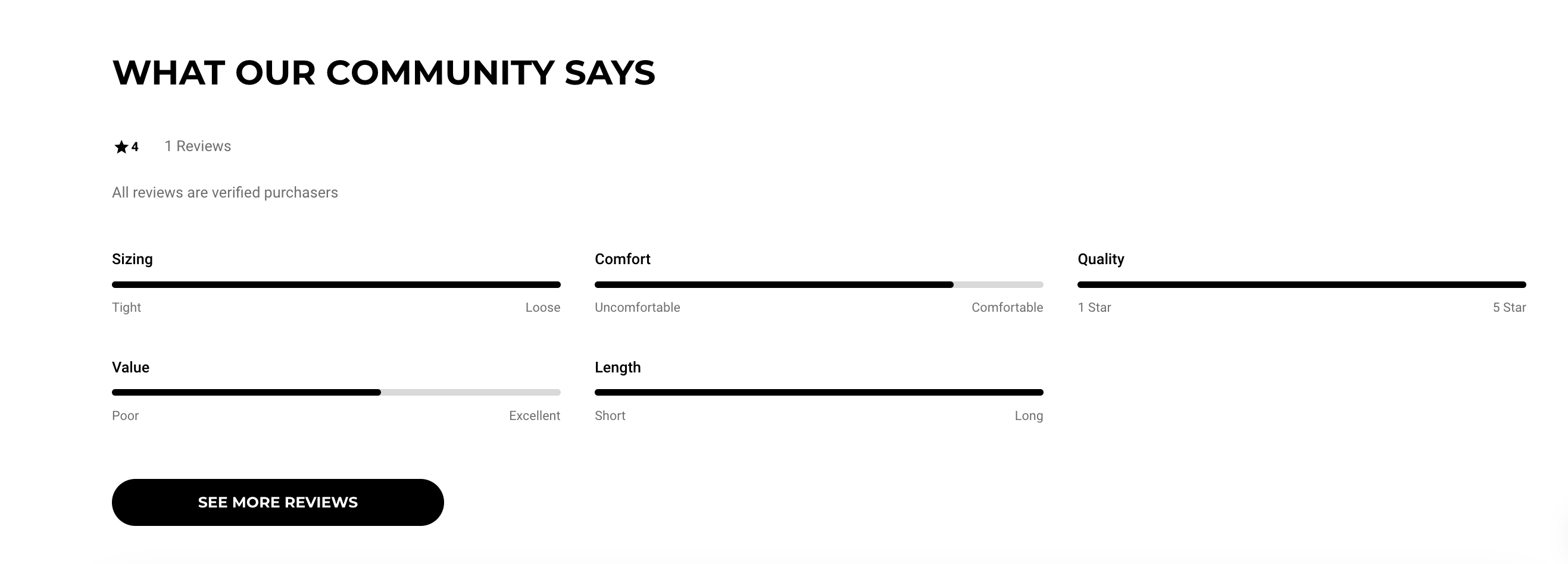
What can you learn from it?
Gymshark’s product pages teach us the importance of visual storytelling and trust-building. Using high-quality images allows customers to fully visualize your product, making them feel more confident in their purchase, while featuring real customer feedback strengthens credibility.
15. Bubble Skincare
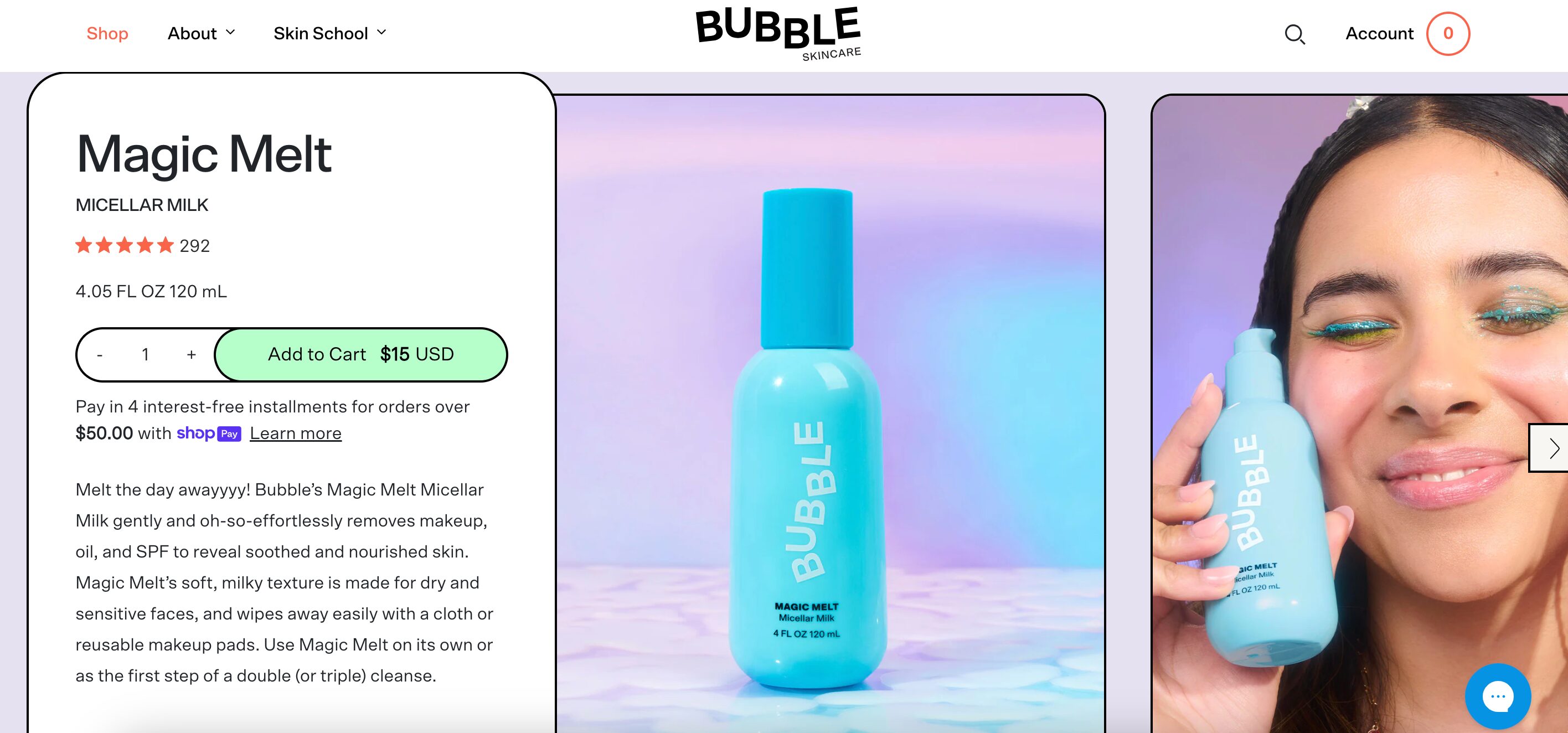
Bubble Skincare stands out with a product page that balances engaging content with essential product details.
The product descriptions are not only informative but also fun and relatable, perfectly aligned with their youthful audience. Paired with beautiful product images, these descriptions help to create a visually appealing and informative shopping experience.
One unique feature of Bubble Skincare’s product pages is the Cheat Sheet—a quick, easy-to-read section that breaks down all the critical information a potential customer needs. This includes benefits, results, skin type, and other key selling points.
To build trust, Bubble Skincare also uses proof points like statistics from customer surveys or clinical tests.
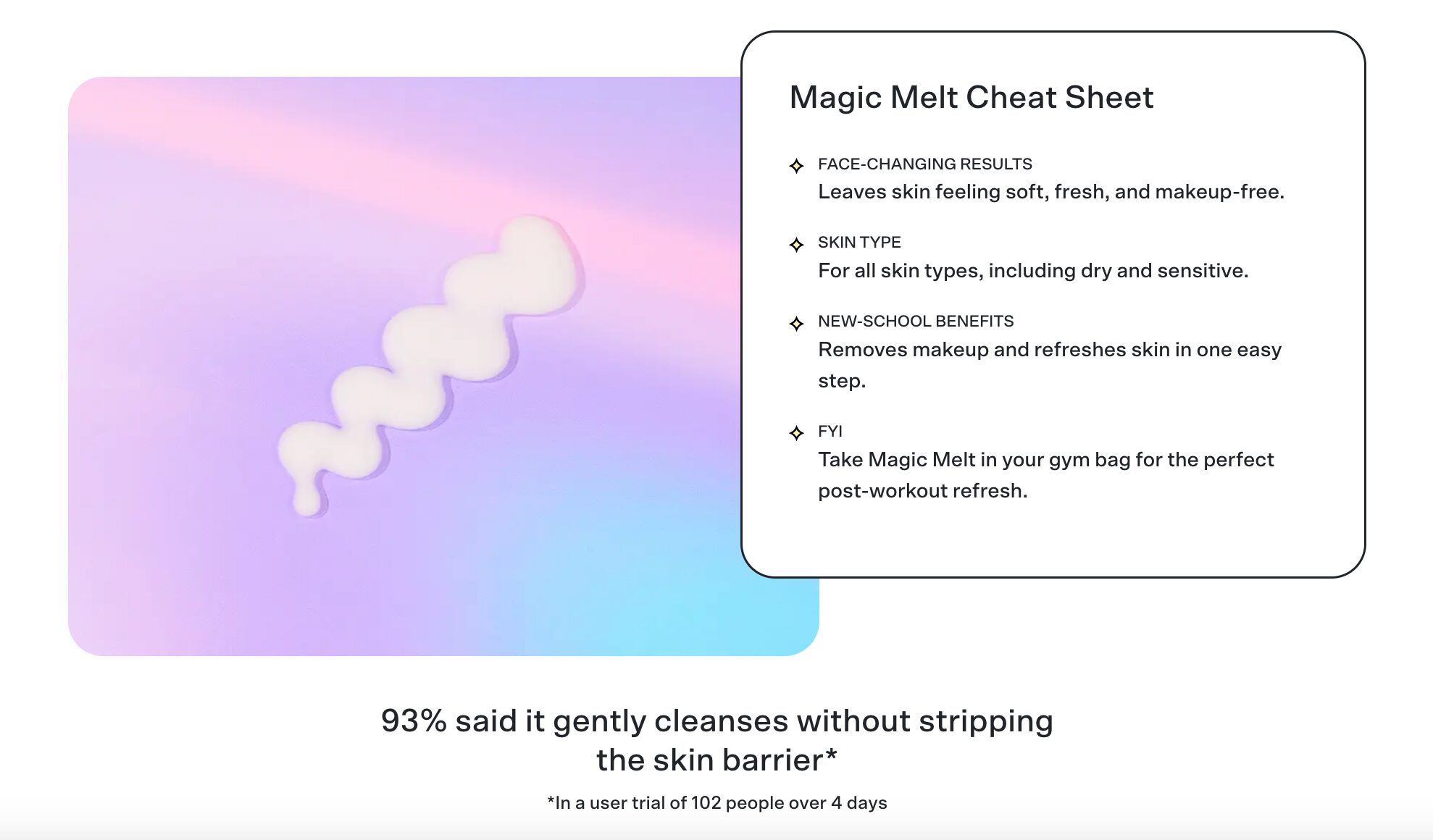
What can you learn from it?
Well-written product descriptions combined with easy-to-digest cheat sheets help customers make quick, confident decisions. Adding data-backed proof further strengthens your product’s credibility. If you want to boost your product pages, consider incorporating clear, concise summaries and statistics that validate your product’s effectiveness.
What makes a good product page?
Now that you’ve seen some outstanding product page examples, let’s quickly recap some of the main lessons that you can apply to your own ecommerce website.
1. Eye-catching visuals
High-quality images and videos are crucial when you’re selling products online, since customers can’t see the items for themselves. You want to make sure that your photos show off the most relevant features from various perspectives.
2. Compelling product descriptions
Use concise, informative, and persuasive product descriptions to provide all the essential details about your product. You should also use a tone of voice that your audience will respond to.
3. Intuitive navigation
You may have noticed that all of our product page design examples have a user-friendly layout. You can use a product page template to design a great product page.
4. A clear call-to-action
Well-placed, compelling CTAs prompt immediate action, which guides potential buyers toward making a purchase now rather than later.
It’s particularly important that your “Buy Now” (and any other call-to-action buttons) are distinct and easy to see.
5. Well-displayed customer reviews and ratings
The best ecommerce product pages and product landing pages prominently display social proof. Authentic customer reviews and ratings can foster trust and credibility.
4 extra tips to boost your online store product page experience
At this point, you probably already have an idea or two about how to improve your own product pages. But we have four extra insider tips that can skyrocket the conversion rates on your product pages!
1. Adapt product page messaging to match the ad copy
Many product pages also operate as landing pages for specific online ads. If you’re running lots of ads on social media platforms or search engines, you should adjust your product page content to match the ad each user clicked on.
For example, if your ad promotes a product that can be used for two use cases, make sure people see the use case that was promoted in the ad.
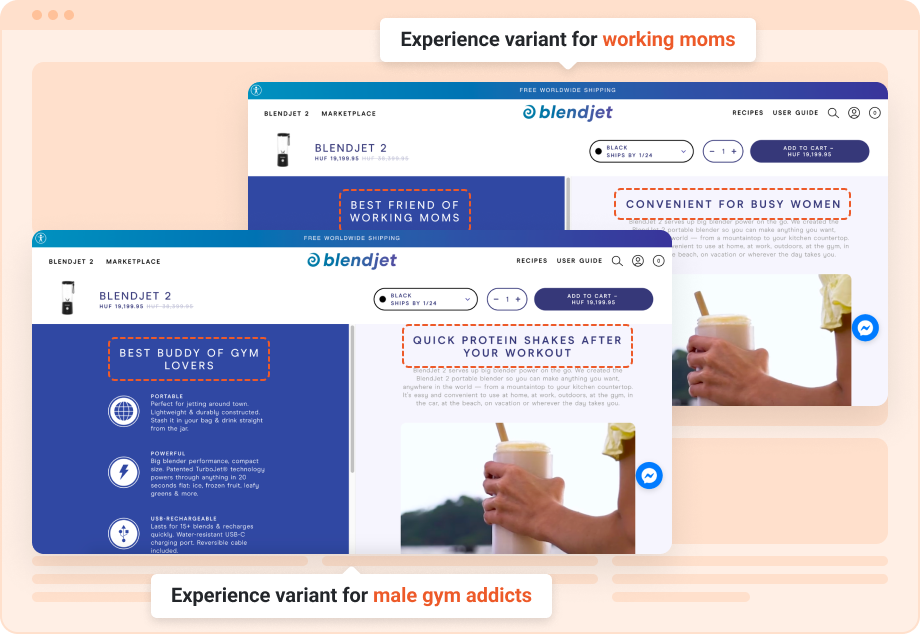
You can easily personalize your product page messaging for diverse customer segments using OptiMonk’s Dynamic Content feature. Many of our clients have increased their conversion rates by at least 10%.
2. Experiment with different value propositions on product pages
Another important way to improve product page conversion rates is by testing variations of your headlines and value propositions.
Even experienced marketers have trouble predicting exactly which version of a USP will resonate with customers, so it’s a good idea to use data-driven insights to find the most compelling one.
By A/B testing different headlines and value propositions, you can boost your conversion rates by between 20 and 25% (and in some cases, we’ve seen even up to 50%).
Check out how jewelry brand Sissora tested out both a feature-focused headline and a version that explained their USP more fully below the headline.


3. Boost order value with post-cart recommendations
We saw a few examples of product page upselling above, which is a great way to increase your average order value.
If you want to use this strategy, we’d recommend using an upsell popup because it will grab your visitors’ attention much more effectively than a small in-page section.
By presenting relevant options at the right moment, you can build excitement and encourage customers to enhance their purchases, leading to a 10% increase in average order value.
You can get started with this upsell popup:
FAQ
What is a product page?
A product page is a digital storefront showcasing a specific item. It can influence purchasing decisions and build brand credibility. The goal of a product page is to catch attention, evoke buying intent, and create a seamless buying process.
What are some key elements of an effective product page?
Effective product pages include high-quality images, informative product descriptions highlighting features and benefits, customer reviews for social proof, and clear call-to-action buttons for easy navigation.
How can I create compelling product images for my product page?
To create compelling product images, you’ll want to use professional photography, capture products from different angles and in various settings, and ensure your images accurately represent the item’s appearance and functionality.
What type of product descriptions should I include on my product page?
Product descriptions should be concise yet detailed, focusing on the product’s unique selling points, materials used, dimensions, and how the product addresses customer needs or solves a problem.
Final words
We hope you’ve gained some insights into what makes product pages work, from the importance of product photos to communicating your brand values through snappy copy.
If you’d like to level up your product pages and start selling more, you can make a free OptiMonk account today. After personalizing your product pages, you’ll be able to generate many more purchases from the same amount of traffic!
Migration has never been easier
We made switching a no-brainer with our free, white-glove onboarding service so you can get started in the blink of an eye.
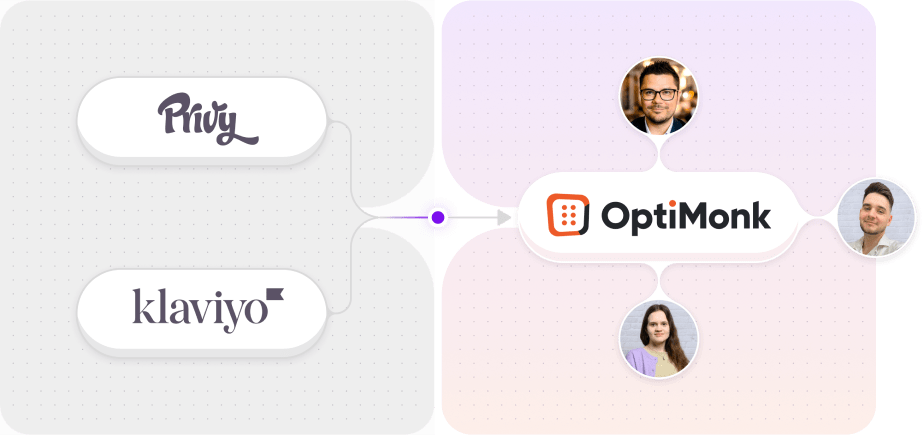
What should you do next?
Thanks for reading till the end. Here are 4 ways we can help you grow your business:
Boost conversions with proven use cases
Explore our Use Case Library, filled with actionable personalization examples and step-by-step guides to unlock your website's full potential. Check out Use Case Library
Create a free OptiMonk account
Create a free OptiMonk account and easily get started with popups and conversion rate optimization. Get OptiMonk free
Get advice from a CRO expert
Schedule a personalized discovery call with one of our experts to explore how OptiMonk can help you grow your business. Book a demo
Join our weekly newsletter
Real CRO insights & marketing tips. No fluff. Straight to your inbox. Subscribe now
Barbara Bartucz
- Posted in
- Ecommerce
Partner with us
- © OptiMonk. All rights reserved!
- Terms of Use
- Privacy Policy
- Cookie Policy
Product updates: January Release 2025

